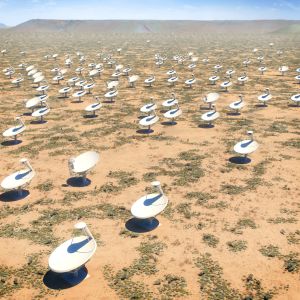Opportunity for Industry – SKA-Low Antenna Assembly & Deployment
08/10/25
Opportunity Description
The Square Kilometre Array Observatory (SKAO) continues to progress the construction of the SKA-Low telescope, located at Inyarrimanah Ilgari Bundara, the CSIRO’s Murchison Radio-astronomy Observatory in Western Australia. To meet delivery milestones and optimise internal resources, the SKAO intends to award a contract for the assembly and deployment of approximately 50,000 lightweight aluminium SKA-Low antennas to a suitably qualified contractor. The estimated contract value is AUD $5 million (€2.8 million), with commencement expected in early 2026 and a duration of 12–24 months, covering full assembly and deployment within the central core area. The SKAO will retain technical oversight of specialised activities such as Power and Signal Distribution (PASD), integration, and system-level commissioning.
Scope of Work
The selected contractor will be responsible for:
- Assembling and deploying antenna stations within the designated core area.
- Coordinating with SKAO-provided antenna assembly facilities on site.
- Managing and transporting personnel, including provision of light vehicles.
- Complying with SKAO’s QA/QC and technical specifications.
- Adhering to site Health, Safety and Environmental (HSE) requirements.
The SKAO will provide:
- Assembly facilities and ergonomic tools.
- Detailed technical documentation and Standard Operating Procedures (SOPs).
- Detailed technical documentation and Standard Operating Procedures (SOPs).
- Detailed technical documentation and Standard Operating Procedures (SOPs).
Each SKA-Low antenna stands approximately 2 metres tall, weighs around 11 kg, and consists of:
- 4 aluminium antenna arms
- 3 plastic spacers
- 2 Low Noise Amplifiers (LNAs)
- 2 coaxial cables
- 1 motherboard
All fasteners, fixings, and ergonomic assembly tools will be provided by SKAO to support on-site work.
Commitment to Local and Indigenous Engagement
The SKAO is committed to supporting economic participation and development opportunities for the Wajarri Yamaji, the Traditional Owners and Native Title Holders of the lands on which the observatory is being built. Local and Indigenous businesses and consortia are especially encouraged to apply, particularly those demonstrating one or more of the following elements:
- Businesses that are at least 50% Wajarri-owned, and registered with the Wajarri Business Directory, the Aboriginal Business Directory WA, or Supply Nation.
- Proposals that include subcontracting or partnering with local and Indigenous businesses.
- Initiatives that deliver sustainable economic and social benefits to the Indigenous community, such as employment, training, or community engagement programs.
Important Dates
- Notice publication period: 8 September – 3 November 2025
- Application deadline: 3 November 2025 (23:59:59 CET)
- Expected contract start: early 2026
Call link
Official qualification notice and documentation available on the SKAO procurement portal..
Opportunity for Industry – Power Supply for the SKA-Low Telescope (Phase 2)
08/10/25
Opportunity Description
The SKA Observatory (SKAO) has published a Market Survey Notice for the SKA-Low Central Power Station Phase 2 project, located at the Murchison Radio-astronomy Observatory (Inyarrimanah Ilgari Bundara) in Western Australia.
The objective of this survey is to gather input from the market on the readiness, capability, and interest of potential suppliers to design, build, and operate a remote hybrid power station that will supply electricity to the SKA-Low telescope site under a long-term Power Purchase Agreement (PPA).
Scope of Work
The selected contractor will be responsible for:
- Designing, building, and operating a hybrid power station (diesel / solar photovoltaic / battery).
- Integrating the existing Phase 1 diesel system into the new Phase 2 infrastructure.
- Integrating the existing Phase 1 diesel system into the new Phase 2 infrastructure.
- Maximising the contribution of renewable energy sources, with an estimated photovoltaic capacity between 8 and 16 MWp.
- Ensuring reliable and efficient power delivery to the SKA-Low telescope through the existing 11 kV network.
Key Requirements
- Demonstrated experience in the design, construction, and operation of hybrid energy systems.
- Technical and financial capability to undertake a long-term PPA.
- Understanding of the regulatory and operational environment in Western Australia.
- Interest and availability to participate in the forthcoming Invitation to Tender (ITT) process to be launched by SKAO.
Commitment to Local and Indigenous Engagement
The SKAO is committed to supporting economic participation and development opportunities for local and Indigenous communities, particularly the Wajarri Yamaji, the Traditional Owners and Native Title Holders of the lands where the observatory is located. Participation is especially encouraged from local and Indigenous companies and consortia that include one or more of the following elements:
- Businesses that are at least 50% Wajarri-owned, and registered with the Wajarri Business Directory, the Aboriginal Business Directory WA, or Supply Nation.
- Proposals that include subcontracting or partnering with local and Indigenous businesses.
- Initiatives that deliver sustainable economic and social benefits to the Indigenous community, such as employment, training, or community engagement programs.
Important Dates
- Preliminary publication of specifications: 8 September 2025
- Planned start of ITT process: to be announced soon
Call link
Official documentation and Market Survey Notice available on the SKAO procurement portal..
Opportunity for Industry – Quality Control Inspection Services in China
11/08/25
Opportunity Description
The Square Kilometre Array Observatory (SKAO) has launched a Market Survey Notice for the provision of inspection and quality control services for large precision metal structures manufactured in China. The work is linked to the production of critical components for the SKA-Mid radio telescope, located in South Africa.
Scope of Work
The contractor will be required to:
- Carry out inspections of materials and components at source.
- Verify measurements and tolerances during production.
- Oversee quality testing and dimensional control.
- Review and approve shipments, including supervision of loading.
- Prepare technical reports and follow up on any issues.
- Support visits by SKAO personnel to suppliers in China.
Key Requirements
- Specialised personnel based in China, available at short notice for on-site inspections.
- Chinese nationality for assigned personnel (security requirement).
Important Dates
- Planned procurement process start date: 18 August 2025
- Deadline to express interest: 15 September 2025
Call link
Market survey and official documentation available on the SKAO procurement portal.
Prof. Jessica Dempsey appointed as the next Director-General of the SKA Observatory
17/07/2025 – Jessica Dempsey will be the next Director-General of the SKA Observatory from June 2026
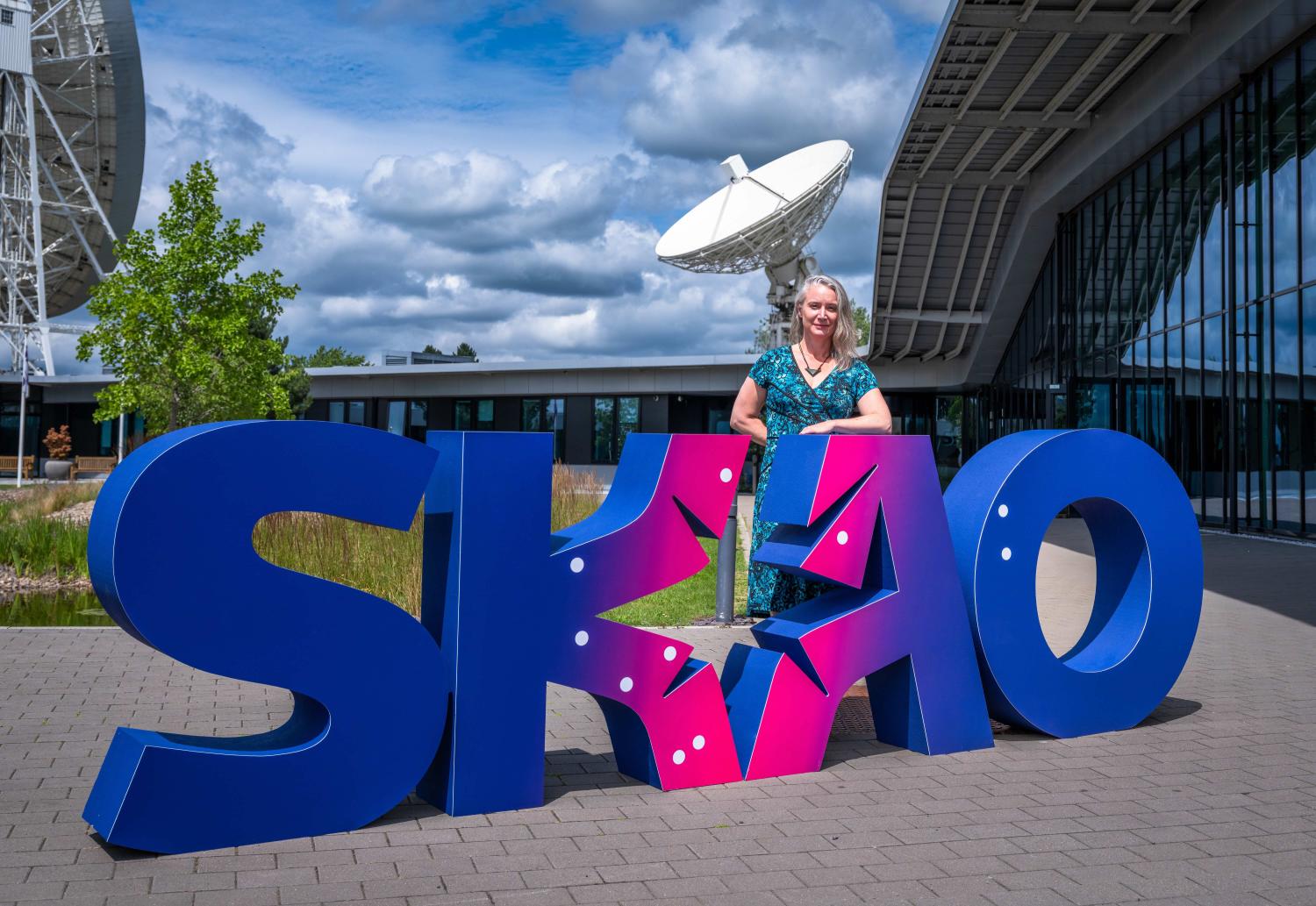
Prof. Jessica Dempsey in front of the SKAO Global Headquarters at Jodrell Bank. Credits: SKAO
The SKA Observatory (SKAO) has announced the appointment of Dr Jessica Dempsey as the next Director General. The current director of ASTRON (Netherlands) will assume the role in June 2026 for a five-year term, taking over from Philip Diamond, who has led the intergovernmental organisation since it was established in February 2021.
Dempsey will lead the SKAO during a key phase that includes the end of construction of the SKA-Low (Australia) and SKA-Mid (South Africa) telescopes, the preparation for the start of the scientific verification phase—scheduled for the first half of 2027—and the project’s transition from construction to its initial scientific operations.
The appointment was approved by the SKAO Council, composed of representatives of the twelve member countries. The decision highlights Dempsey's strong experience in managing large international scientific infrastructures and his commitment to the principles of diversity, equity and inclusion.
More information: skao.int
EOSOL and COMPOXI pass the DDR of the SKA-Mid subreflectors
25/06/2025 – Spain strengthens its strategic role in the SKA Observatory: EOSOL and COMPOXI successfully complete the Detailed Design Review of the SKA-Mid telescope sub-reflectors.
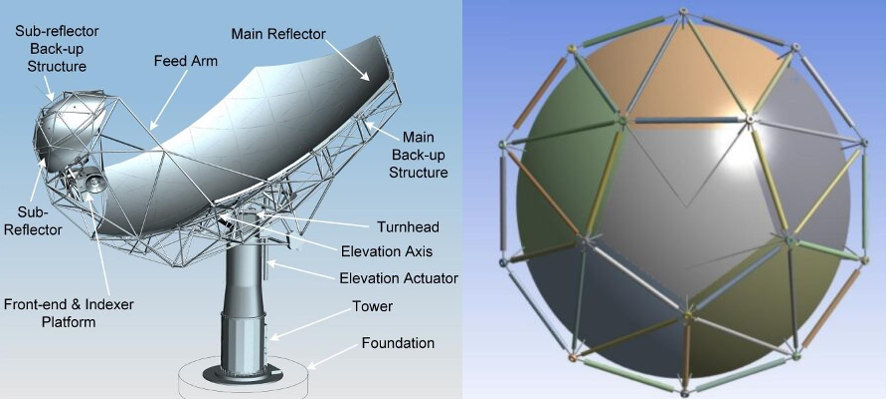
3D models of a SKA-Mid antenna and its subreflector (Credits: SKAO and EOSOL)
The coordination team for Spain’s participation in the SKA project is pleased to announce that the Spanish companies EOSOL and COMPOXI have successfully passed the Detailed Design Review (DDR) for the construction project of the sub-reflectors for the SKA-Mid radio telescope. This milestone represents a decisive step in Spain’s contribution to one of the most ambitious and large-scale scientific engineering projects of the 21st century.
The successful completion of this phase validates the developed technical design and paves the way for the manufacturing stage of the 44 sub-reflectors to be integrated into the SKA-Mid antenna array, currently under construction in South Africa. This achievement is the result of several months of close collaboration between EOSOL, COMPOXI, and the technical team at the SKA Observatory, and it highlights the advanced technological capabilities of the Spanish industrial sector.
The sub-reflectors—a critical component responsible for directing incoming signals to the receivers—have a diameter of 4.5 meters and are made of composite materials with a metallized surface to ensure both mechanical stability and demanding electromagnetic performance. Each unit comprises over 100 individual parts, including six main panels and three extensions, all of which must be assembled with high precision.
We emphasize the strong collaboration between COMPOXI, a company specialized in the design and manufacturing of composite structures, and EOSOL, a leading provider of engineering services for strategic sectors. This kind of synergy exemplifies the ability of the Spanish industrial sector to make substantial and effective contributions to large-scale international scientific infrastructures.
The SKA Observatory, with core sites in South Africa and Australia, will host the most advanced radio telescopes on Earth, enabling the global scientific community to explore the Universe with unprecedented resolution and scope. Spain’s active participation—at the institutional, scientific, and industrial levels—reinforces its role as a strategic partner within this intergovernmental organization.
It is worth noting that this contract has been partially funded by the European Union through the NextGenerationEU programme, managed by the Spanish Ministry of Science, Innovation and Universities. This reflects the significant impact of public investment in research and innovation on the international visibility and competitiveness of Spain’s technological capabilities.
About Grupo EOSOL:
The EOSOL Group is a global engineering, monitoring and technical support services company with experience in more than 40 countries around the world. The aerospace division develops antennas and RF components for the space, defence and scientific sectors. We provide our customers with high-performance antenna solutions. The division covers all tasks related to the study and implementation of antennas and RF components (feasibility study, detailed design, prototyping, qualification and production).
For more information, please visit their website.
About Compoxi
Compoxi is a leading company in the design and production of composite structures. Compoxi combines advanced design, analysis, qualification and prototyping capabilities with industrial means that enable it to carry out serial production. Compoxi's portfolio encompasses the design and production of primary structures for satellites and launchers for the space sector, structural components for aeroplanes, helicopters and UAVs for the aeronautical sector and critical elements for scientific and industrial structures.
For more information, please visit their website.
The SKAO, a balcony to the Universe with its heart on Earth
29/05/2025 – The SKAO, a balcony to the Universe with its heart on Earth 05/29/2025 – SKAO, a balcony to the Universe with its heart on Earth, is the title of a public talk in the Lucas Lara lecture series, which will take place on Thursday, May 29 at 7:00 p.m. in the IAA-CSIC Auditorium, Granada, Spain.
The speaker is Lourdes Verdes-Montenegro, who has coordinated Spanish participation in this project since its inception. This is a great opportunity to learn how a large astronomical observational facility, with unprecedented sensitivity and complexity, is conceived, built, and organised. Also, to learn about the construction of these telescopes in remote regions of South Africa and Australia.
In this talk, we'll learn about the latest developments and Spain's participation in the project. We'll also learn about the status of the SKA International Network of Regional Centres, for which one node is being developed in Spain. These centres are essential for the community to access the vast amount of data the telescopes will generate and to benefit from tools, technical support, and specialised training.
From this point on, we will open a window to the lesser-known dimensions of SKAO: the challenge of interference caused by mega-satellite constellations, cooperation with Africa and Indigenous tribes in Australia, Open Science, respect for the environment, and the creation of opportunities beyond science. This is an invitation to observe the Universe with the most advanced technology... and with your feet firmly on the ground.
Poster:
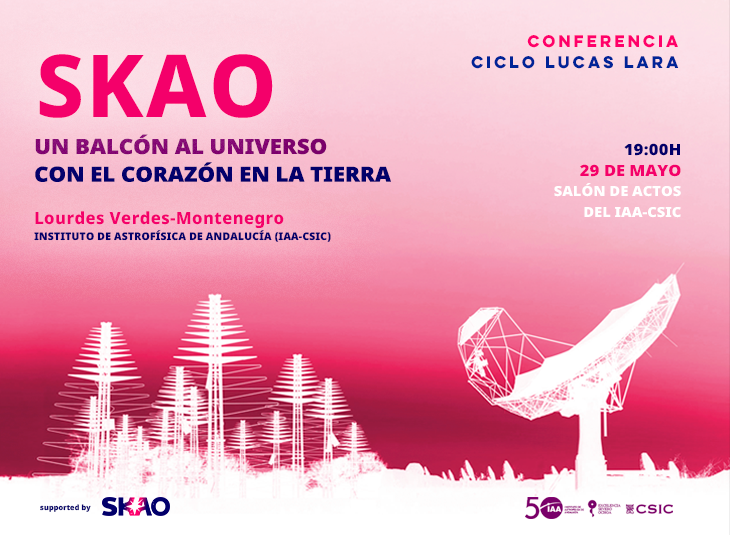
SKA-Low captures its first image of the universe
March 17, 2025 – The first image from the SKA-Low radio telescope was released today. SKA-Low is part of the SKA Observatory (SKAO) and is located in Australia. This marks a significant milestone in SKAO's mission to provide an unprecedented view of our universe.
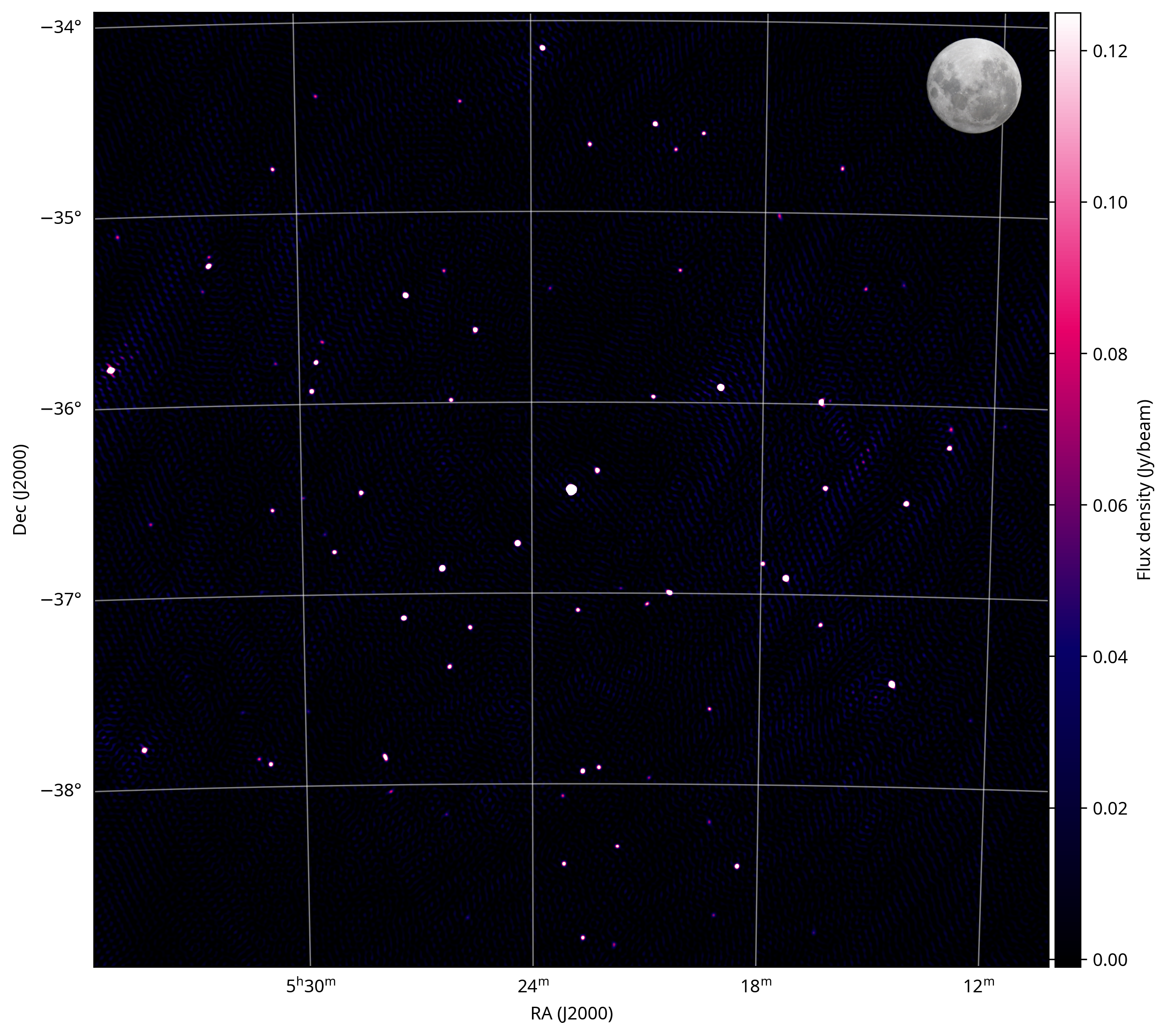
The first image using four stations of SKA-Low. The full moon in the upper right corner is shown for image size reference. Credit: SKAO
The image covers an area of the sky approximately 25 square degrees in size, equivalent to about 100 full moons. It displays 85 of the brightest known galaxies in that region, all of which contain supermassive black holes. The image was obtained with an early version of the SKA-Low telescope, one of two telescopes being built by SKAO. This early version of SKA-Low consists of just 1,000 of the planned 131,000 antennas. Once completed, the telescope will be able to reveal many more objects; scientists estimate it will be able to detect more than 600,000 galaxies in the same region of the sky.
SKAO is currently building two radio telescopes: SKA-Low in Western Australia and SKA-Mid in the Northern Cape Province of South Africa. The telescopes are arrays of 15-meter parabolic antennas (SKA-Mid) and dipole antennas (SKA-Low), spread over large distances. Two Spanish companies, Safran Electronics & Defense Spain and EMITE, are playing a key role in the construction of SKA-Low, providing high-precision synchronization systems between the antennas and equipment for testing and validating electronic components. "Synchronizing the signals from the different antennas is crucial for combining them correctly. Furthermore, to avoid interference, it is necessary to test that all electronic components do not generate noise in radio waves that could affect the signal from the astronomical objects being observed," explains Dr. Julián Garrido, deputy technology coordinator at SKA-Spain, adding: "For this same reason, the telescopes are being built in remote, sparsely populated locations, minimising human-caused interference."
SKA-Low is being built at Inyarrimanha Ilgari Bundara, the CSIRO Murchison Radio Astronomy Observatory, which is located on the lands of the Wajarri Yamaji Aboriginal people, the traditional owners and native land title holders. The location's Aboriginal name, Inyarrimanha Ilgari Bundara, means "sharing the sky and stars", and reflects the commitment and collaboration between SKAO and the Indigenous peoples and cultures who inhabit the lands where its telescopes are being built.
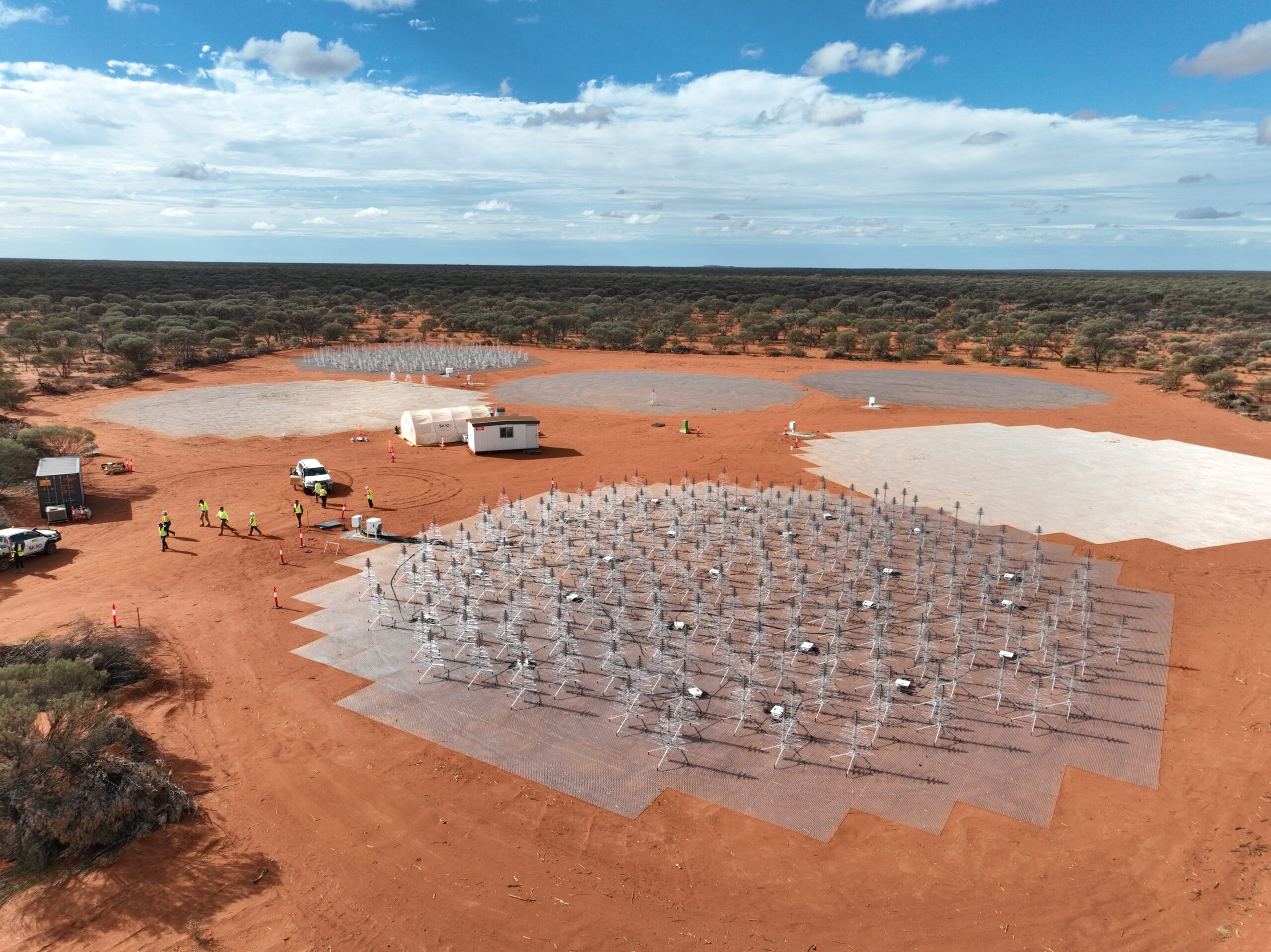
Drone image of SKA-Low's S8 cluster with two stations completed from June 2024. Credit: SKAO
The acquisition of this image has verified the telescope's operation and capabilities. Professor Philip Diamond, Director General of the SKAO, said the image marks the observatory's debut as a scientific facility. "With this image we see the promise of the SKA Observatory as it opens its eyes to the Universe," said Professor Diamond. "This first image is a critical step for the Observatory, and for the astronomy community; we are demonstrating that the system as a whole is working. As the telescopes grow, and more stations and dishes come online, we’ll see the images improve in leaps and bounds and start to realise the full power of the SKAO."
The SKAO telescopes are being built in phases, with components sourced from SKAO member countries around the world. Dr. Lourdes Verdes-Montenegro, coordinator of Spain's participation in the SKAO, highlighted the international nature of the observatory: "This milestone has been possible thanks to an international collaboration between scientists and engineers from academia and industry. Sixteen countries from five continents are participating in the SKA project, and the impact it is already having and will have will be global thanks to SKAO's commitment to the scientific community and international society as a whole."
The Spanish participation in the SKAO is funded by the Ministry of Science, Innovation and Universities, with the Andalusian Institute of Astrophysics (IAA-CSIC) responsible for the national scientific and technical coordination of the project.
This animation shows the various stages of deployment of the SKA-Low telescope over the coming years, and the images it is expected to produce of the same area of the sky. Credit: SKAO
Links of interest
Associated multimedia materials https://skao.canto.global/b/LTFMH
SKAO press release: https://www.skao.int/en/news/621/ska-low-first-glimpse-universe
Reunión: Una nueva era en la astrofísica: preparación para la ciencia temprana con la SKAO Görlitz, Alemania, 16-20 de junio de 2025
23/01/2025 - A new era in astrophysics: Preparing for early science with the SKAO Görlitz, Germany, 16-20 June, 2025
Abstract deadline: February 7, 2025
Registration is now open, early reduced-rate registration closes March 31.
More information and registration:
https://www.skao.int/en/science-users/skao-science-meeting-2025
Taking place just two years before the SKA telescopes will be tested on the first community-chosen targets, the meeting will bring together scientists from across the globe to discuss and collaborate on the cutting-edge science opportunities that the SKAO will provide in its early years of operations. Online participation will be supported for the whole week for those unable to attend in person.
Full details about the meeting are available at the #SKAOsci2025 website. #SKAOsci2025.
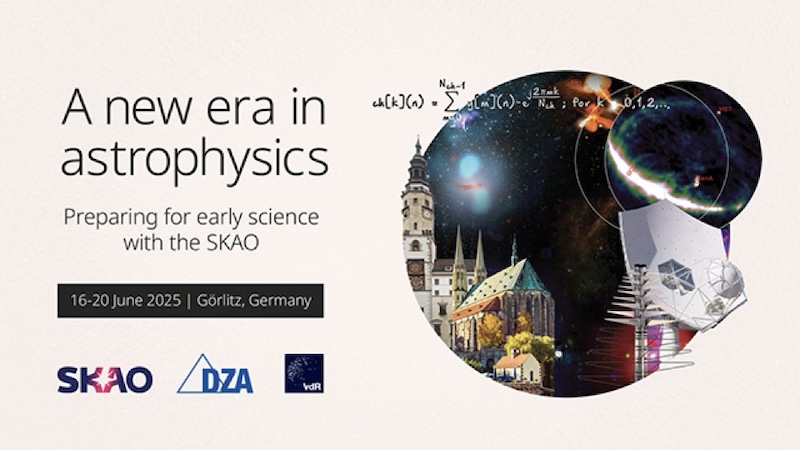
New deadline for Advancing Astrophysics II, the SKAO White Book update
Note that the SKAO White Book early draft deadline has been adjusted, and instead there is a general deadline for chapter submissions of September 2025,whereupon a peer review process will commence.
Chapters will have a maximum length of 8 pages. More info, latex templates, etc, available here: https://www.skao.int/en/science-users/557/advancing-astrophysics-ii
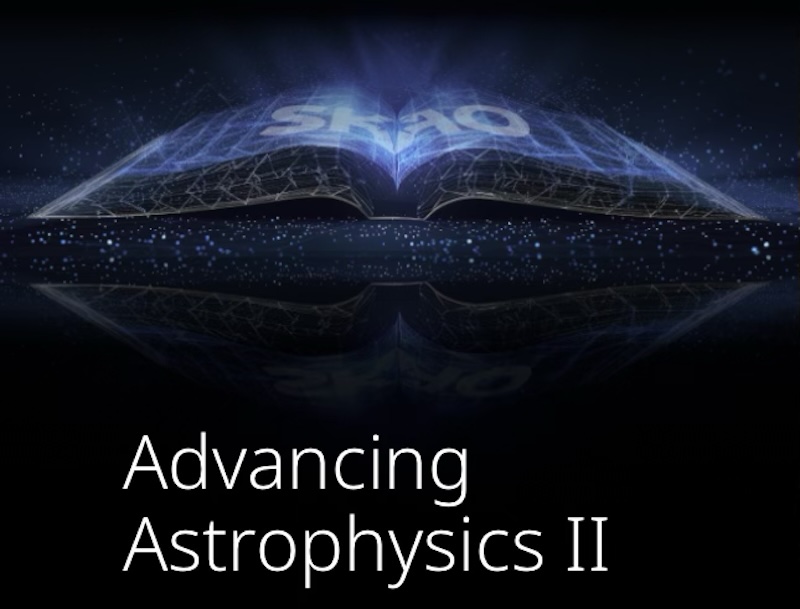
Record-breaking radio transient discovery with MWA
22/01/2025 - A radio transient with the longest period yet seen, 2.9 hrs, was discovered by a team including Nanda Rea of ICE-CSIC and published in December 2024.
The team found the transient in low-frequency archival data from the SKAO precursor Murchison Widefield Array (MWA). Such long-period radio transients are a fairly new area of research and it is challenging to determine how the signals are generated. In this case, the team managed to find the probable source for the energy bursts, using another SKA precursor, MeerKAT, and optical SOAR observatory, and determine that the optical counterpart is a cool M3 dwarf star. This means that the signal is not due to a magnetar, but more likely is generated in a dwarf binary system scenario.
Read more:
ICE-CSIC press release
ICRAR press release
Paper: Hurley-Walker et al., 2025
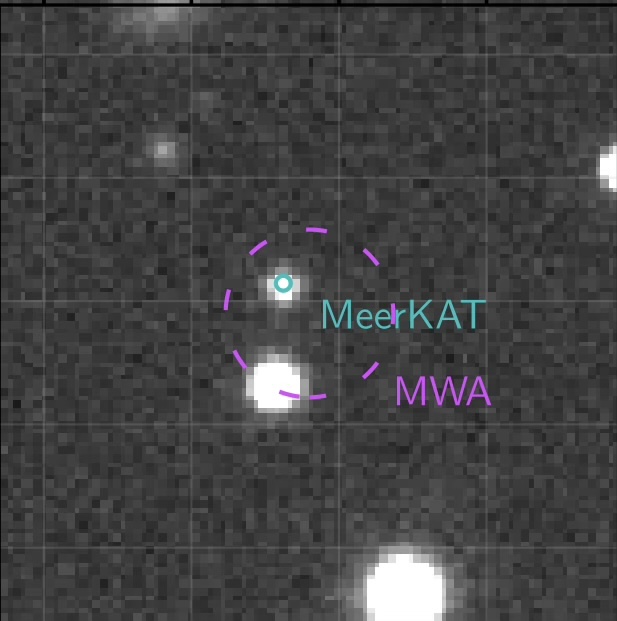
Using 2 SKAO precursors, the team could trace the 2.9 hr long-period transient radio source to a specific object and measure its counterpart in optical to find an M3 dwarf star. Image credit: Hurley-Walker at al, 2024..
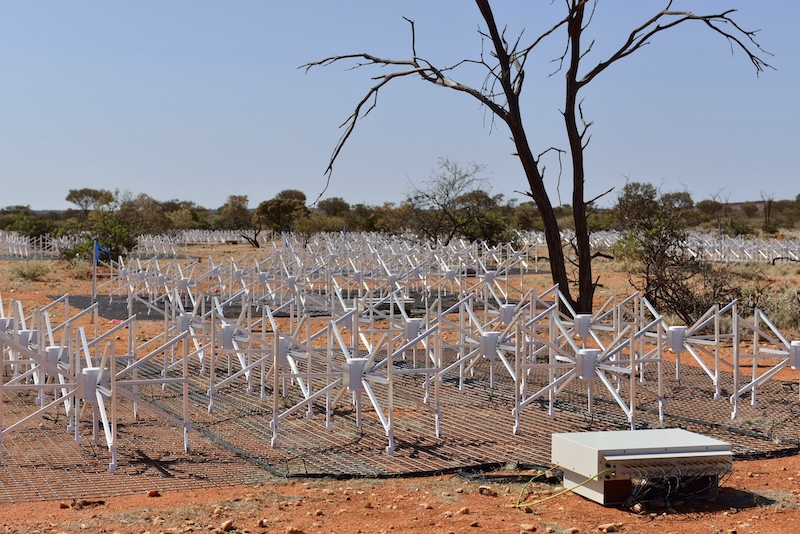
The team found the radio signal in archival data from the Murchison Widefield Array radio telescope, an SKAO precursor. Image credit: ICRAR/Curtin.
Invitación a la comunidad científica internacional para contribuir a la actualización del libro de ciencia de SKA
01/09/2024 – El Observatorio SKA abre a la comunidad científica internacional la convocatoria para contribuir a la nueva edición del libro de ciencia SKA hasta el próximo 30 de septiembre.
El próximo año, durante la Reunión General de Ciencia del Observatorio SKA (SKAO) que se celebrará del 16 al 20 de junio, se cumplirá una década desde la publicación del libro de ciencia de SKA «Advancing Astrophysics with the Square Kilometre Array«. Este libro, escrito por la propia comunidad internacional, documenta los avances científicos que serán posibles gracias a los telescopios del SKA. En estos diez años, el diseño se ha cerrado, la construcción ha comenzado y la Organización SKA se ha transformado en un observatorio en forma de organización intergubernamental que abarca cinco continentes y ambos hemisferios.
Durante este tiempo, las observaciones realizadas con los telescopios precursores y pathfinders de SKA han arrojado nueva luz sobre enigmas científicos ya existentes y han descubierto nuevos fenómenos a la espera de una respuesta. Ahora, el SKAO está listo para comenzar las primeras pruebas para su puesta en marcha, con lo que las actividades de observación irán incrementando rápidamente. Los primeros datos de verificación científica estarán disponibles públicamente para la comunidad en 2027, y las operaciones con ambos telescopios comenzarán en 2029.
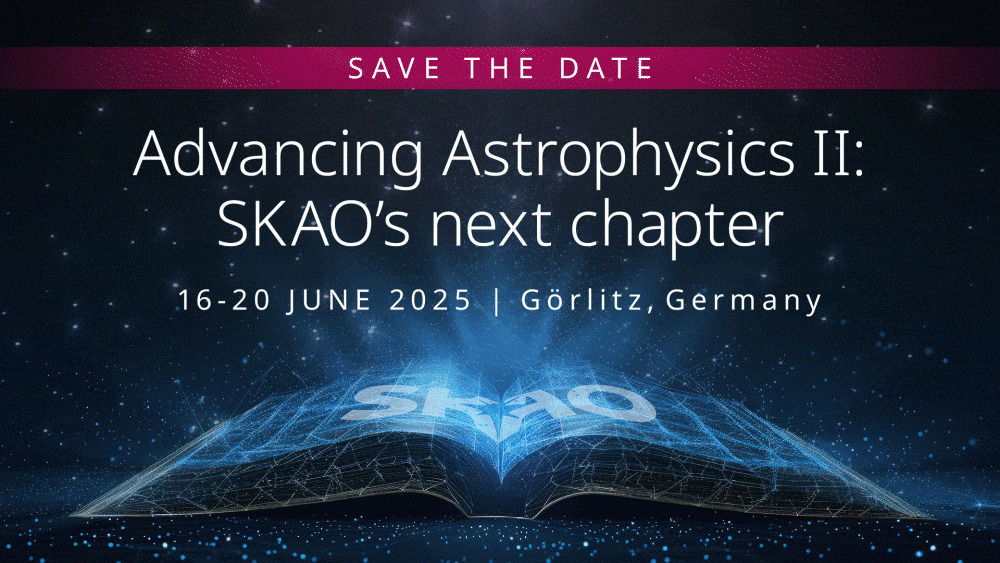
Credit: SKA Observatory
En este momento crítico, SKAO invita a la comunidad científica a contribuir a redactar una nueva versión del libro de ciencia del SKAO. El objetivo es proporcionar una cobertura actualizada de las preguntas científicas que abordarán los telescopios del SKA que esté redactada sobre la base de un conjunto maduro de especificaciones y con una variedad de herramientas y documentos disponibles basados en trabajos de diseño detallados y características del entorno de los telescopios del SKA.
El SKAO ha puesto a disposición de la comunidad científica una página donde se encuentran los detalles sobre la presentación de las expresiones de interés en contribuir con un capítulo del libro y sobre la Reunión General de Ciencia del SKAO 2025. Desde el equipo de coordinación de SKA-Spain, animamos a la comunidad española, especialmente al personal que se encuentra en etapas tempranas de sus carreras, a contribuir al libro, ya sea actualizando casos científicos existentes o incluyendo nuevos casos no cubiertos anteriormente. La convocatoria de Expresiones de Interés se cerrará el 30 de septiembre de 2024, serán revisadas por los presidentes de los Science Working Groups de SKA y se invitará a todas las ideas científicas viables a prepararse como capítulos para el libro.
Esta iniciativa presenta una oportunidad única para la comunidad científica española de influir en la dirección de la investigación astronómica internacional de los próximos años. España, como país miembro de SKAO, tendrá acceso tanto a los Key Science Projects (KSPs – proyectos de legado que ocuparan el ~ 70% del tiempo en los primeros 5 años de operaciones) como al tiempo asignado para propuestas de IP, que será proporcional al porcentaje de participación de cada país miembro. Al actualizar y añadir nuevas ideas al libro, la comunidad española podrá contribuir a maximizar el potencial científico de los telescopios del SKA y asegurar que éstos aborden el interés científico nacional, con el objetivo de mantener a la comunidad a la vanguardia de los descubrimientos astronómicos.
En conclusión, la nueva edición del libro de ciencia SKA será una guía esencial para los futuros estudios astronómicos y una plataforma para la colaboración internacional. Desde SKA-Spain, invitamos a todos los interesados a participar en esta emocionante aventura científica y a contribuir con sus conocimientos y experiencias para hacer de esta publicación un recurso valioso y actualizado para la comunidad científica global.
Outstanding presence of the SKA project at the 16th Scientific Meeting of the SEA
02/08/2024 – More than 630 participants gathered in Granada to discuss the latest developments in astronomy. The SKA project was extensively discussed, with key presentations on its technological and scientific capabilities, underlining the importance of Spanish collaboration in this global research infrastructure.
From July 15th to 19th, the XVI Scientific Meeting of the Spanish Astronomical Society (SEA, for its acronym in Spanish) was held in Granada, with a record attendance of over 630 participants and more than 400 scientific talks. During this meeting, the latest scientific and technological advances in astronomy and the Spanish participation in major projects and research infrastructures were shared. Among these, the SKA project played a prominent role, as it was the subject of the inaugural plenary lecture, a special session, and also featured in another plenary and talks in various parallel sessions.
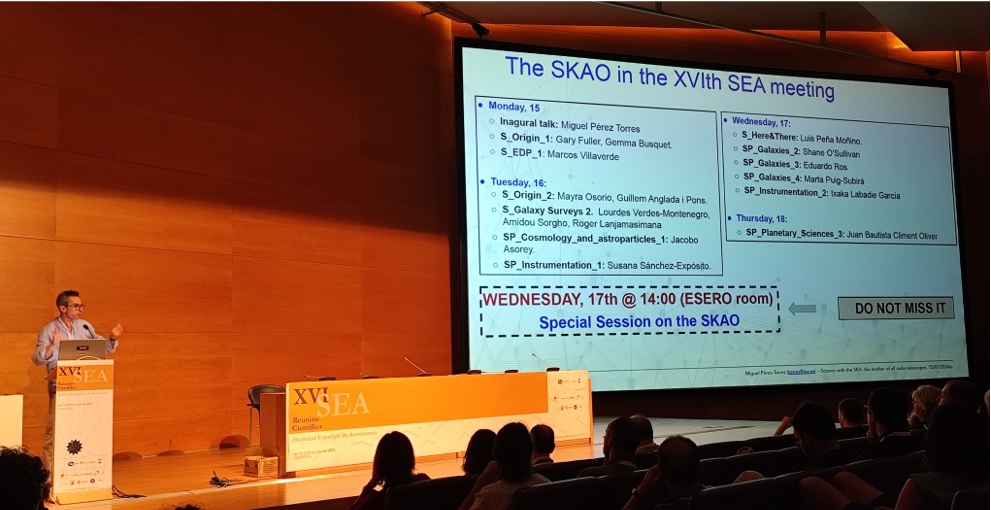
Inaugural plenary lecture “Science with SKA: the mother of all radio telescopes” by Miguel Pérez-Torres (IAA-CSIC)
In the inaugural talk, Miguel Pérez-Torres (IAA-CSIC) discussed the capabilities of SKAO telescopes and the scientific research that can be conducted with them, encouraging all attendees to become part of the SKA community by participating in the Science Working Groups. This talk can be watched in full on the SEA's YouTube channel (link). The special session on SKA focused on the latest developments at the SKA Observatory and its international network of Regional Centres (SRCNet), addressing topics such as: the timeline for the construction of SKAO telescopes, updates on scientific cases, the SKA Science Conference to be held in June 2025, the tools already available to the community, the services offered by the Spanish prototype of SKA Regional Centre at IAA-CSIC (espSRC), and the launch of the first functional version of the SRCNet in early 2025.
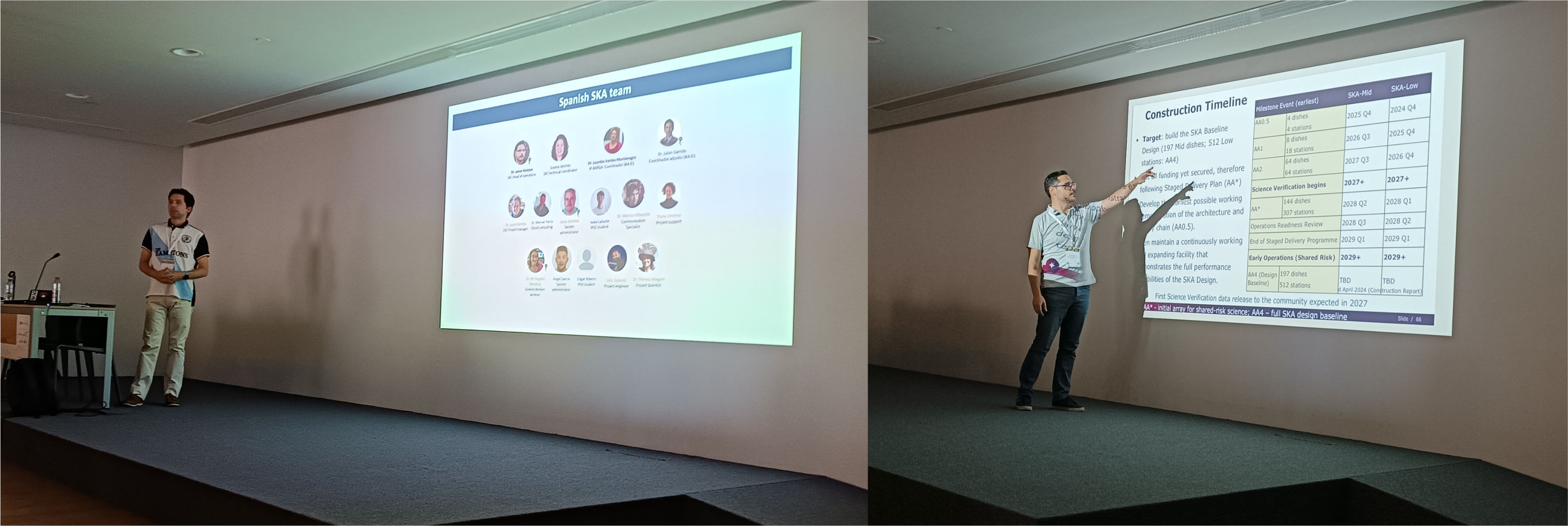
Julián Garrido (IAA-CSIC) and Javier Moldón (IAA-CSIC) during the special session on SKA
The plenary talks on the second day included a presentation by Vanessa Graber (University of Hertfordshire). In this talk, she summarised the work she conducted at the Institute of Space Sciences (ICE-CSIC) on pulsars and long-period radio transients, highlighting observations made with the Murchison Widefield Array, one of the SKAO precursors in Australia. This talk can also be viewed on the SEA's YouTube channel (link).
In the parallel sessions, the SKA project was also discussed from the scientific, technological and science communication aspects. The invited talks by Susana Sánchez (IAA-CSIC) and Lourdes Verdes-Montenegro (IAA-CSIC) were particularly focused on the SKA project. Susana Sánchez discussed Spain's contribution to SRCNet and the TED4SKA project, which aims to reduce the energy consumption of SKA Regional Centres. Lourdes Verdes-Montenegro provided a review of the study of galaxies and their environments using HI observations with SKA precursors and pathfinders.
También se presentaron otras tres charlas sobre observaciones con precursores y pathfinders de SKA: Jacobo Asorey (UCM) habló sobre Cosmología con surveys de ASKAP, Roger Ianjamasimanana (IAA-CSIC) presentó un trabajo sobre el gas en grupos compactos de Hickson realizado con observaciones de MeerKAT y Shane O’Sullivan (UCM) sobre observaciones del medio intergaláctico magnetizado realizadas en los surveys LOTSS de LOFAR y POSSUM de ASKAP.
In the instrumentation and supercomputing session, Ixaka Labadie (IAA-CSIC) presented his research on remote and interactive visualisation of spectral data cubes implemented in the espSRC, which is already being applied to MeerKAT data, a SKA precursor telescope. In a different area, Marcos Villaverde (IAA-CSIC) spoke in the session dedicated to education, outreach, and heritage about the outreach initiatives carried out by SKAO and the role of Open Science in dissemination. It is also worth mentioning a poster by David Alonso-López (UCM) on work conducted within the POSSUM-ASKAP collaboration concerning the magnetised gas in the Shapley supercluster
In addition to all this, SKAO and its telescopes were featured in other talks as a reference for the future. All of this reflects the Spanish community's interest in the SKA project and its science.
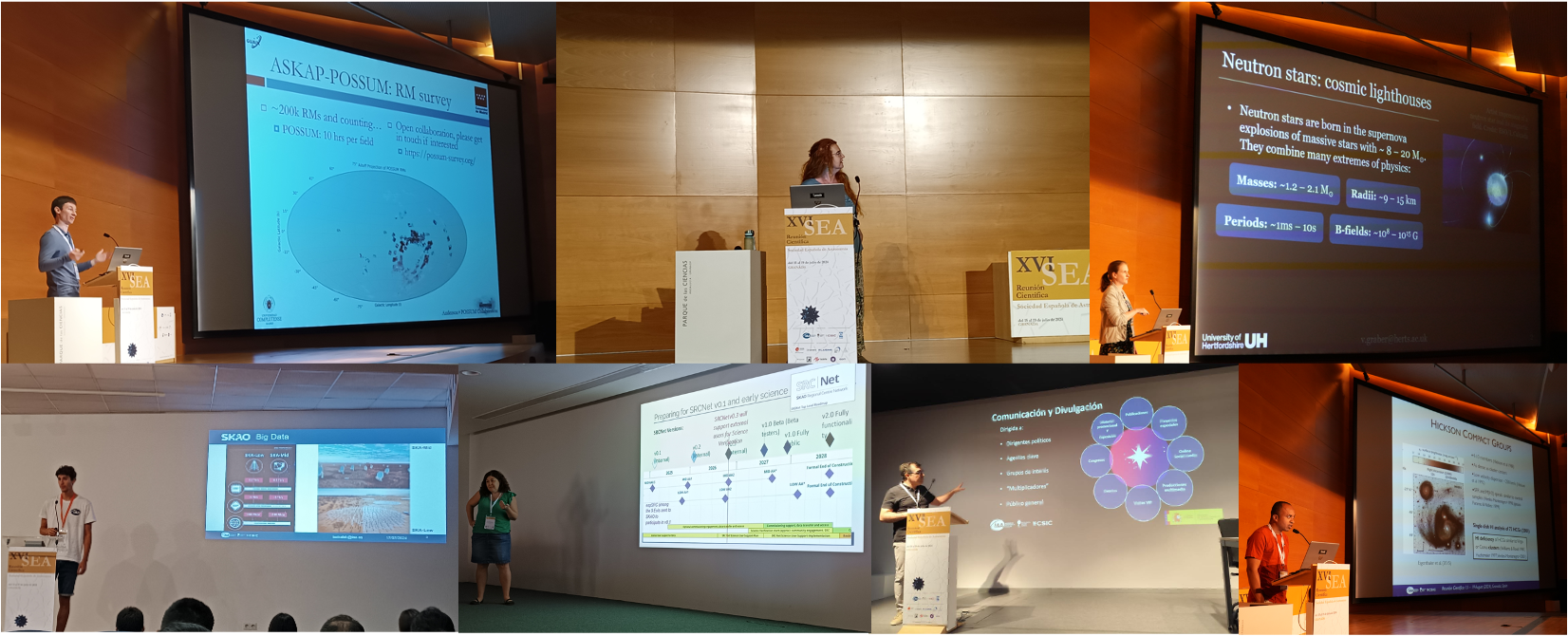
From left to right and from top to bottom: Shane O’Sullivan (UCM), Lourdes Verdes-Montenegro (IAA-CSIC), Vanessa Graber (University of Hertfordshire / ICE-CSIC), Ixaka Labadie (IAA-CSIC), Susana Sánchez (IAA-CSIC), Marcos Villaverde (IAA-CSIC) and Roger Ianjamasimanana (IAA-CSIC)
Granada hosts first SKA Open Science school as hybrid meeting
22/06/2023 – The emerging era of Big Data is demanding a transformation in the way science is done via a growing push to make scientific research more accessible, a movement known as 'Open Science'. To explore what this means in practice for researchers, the first SKA Open Science School took place in Granada, Spain, from 8-10 May 2023, bringing together 80 participants from 14 countries.
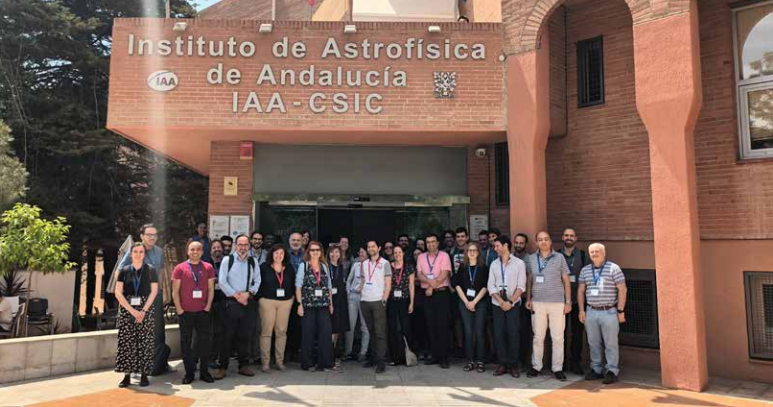
The IAA-CSIC Severo Ochoa Open Science school at the Institute of Astrophysics of Andalusia was organised as a fully hybrid meeting, with around 50% of its participants attending online. Credit: IAA-CSIC
The hybrid school was endorsed by the SKA Regional Centre partner training programme and co-organised with the SKAO under the IAA-CSIC Severo Ochoa Programme.
Participants ranged from graduate students looking for tips on making their thesis work reproducible (making tools and techniques public so that others – and even the original researchers themselves – can achieve the same results later), to the already Open Science-savvy wanting to learn practical tools. Instructors discussed transitions in science practices with accompanying challenges, and presented practical solutions, including hands-on demos. They covered topics on how to make projects/code portable throughout new versions of software, how to best use containers and science platforms, virtual observatories, setting up citizen science projects, licenses, and more.
Discussions continued between sessions on how to change habits that give quick, publishable results (the “publish-or-perish” mentality) and instead invest the time needed for long-term open and reproducible science, including how Open Science work can be appreciated by employers. As Prof. Eva Mendez of Charles III University of Madrid (UC3M) asked: “Are we prepared for a new research evaluation?”
SKAO Scientist Dr Philippa Hartley shared the new SKAO statement on Open Science, including its mission and what Open Science will do for the SKA, and the IAA’s Dr Lourdes Verdes-Montenegro, coordinator of the Spanish participation in the SKA, noted that “large scientific infrastructures have an ethical role and a practical need in Open Science”.
Sessions from the Open Science school are publicly available on the school webpage.
The first radio detection of a type Ia supernova sheds light, after decades of debate, on the origin of these explosions
17/05/2023 – These bursts, which show a similar luminosity in almost all cases, are used to measure distances in the universe or to study dark energy. The study, in which the Institute de Astrophysics de Andalusia (IAA-CSIC) participates, shows that the explosion occurred in a double star system in which a white dwarf stole material from its solar-type companion. El trabajo, en el que participa el Instituto de Astrofísica de Andalucía (IAA-CSIC), muestra que la explosión se produjo en un sistema doble de estrellas en el que una enana blanca robaba material de su compañera, de tipo solar.
Type Ia supernovae are produced when a white dwarf, the "corpse" of a Sun-like star, absorbs material from a companion star and reaches a critical mass, equivalent to 1.4 solar masses, triggering an explosion whose luminosity will, given its origin, be similar in almost all cases. This uniformity made Type Ia supernovae the ideal objects for measuring distances in the Universe, but the origin and nature of the progenitor system was unknown. Now, the first radio observation of a type Ia supernova confirms that it comes from a double star system consisting of a white dwarf and a solar-type star. The results are published in the journal Nature.
"When we saw signs of a strong interaction with the companion star material in supernova SN2020eyj, we tried to observe the explosion in radio, something that had been attempted without success for decades", explains Erik Kool, a researcher at Stockholm University and lead author of the paper.
Type Ia supernovae always contain a white dwarf, which receives material from its companion. However, it was not known whether this companion was a white dwarf or a Sun-like star, something that radio imaging could reveal.
“This first radio detection of a type Ia supernova is a milestone that has allowed us to demonstrate that the exploded white dwarf was accompanied by a normal, non-degenerate star before the explosion", says Javier Moldón, a researcher at the IAA-CSIC who participated in the discovery. In addition, with these observations we can estimate the mass and geometry of the material surrounding the supernova, which allows us to better understand what the system was like before the explosion.
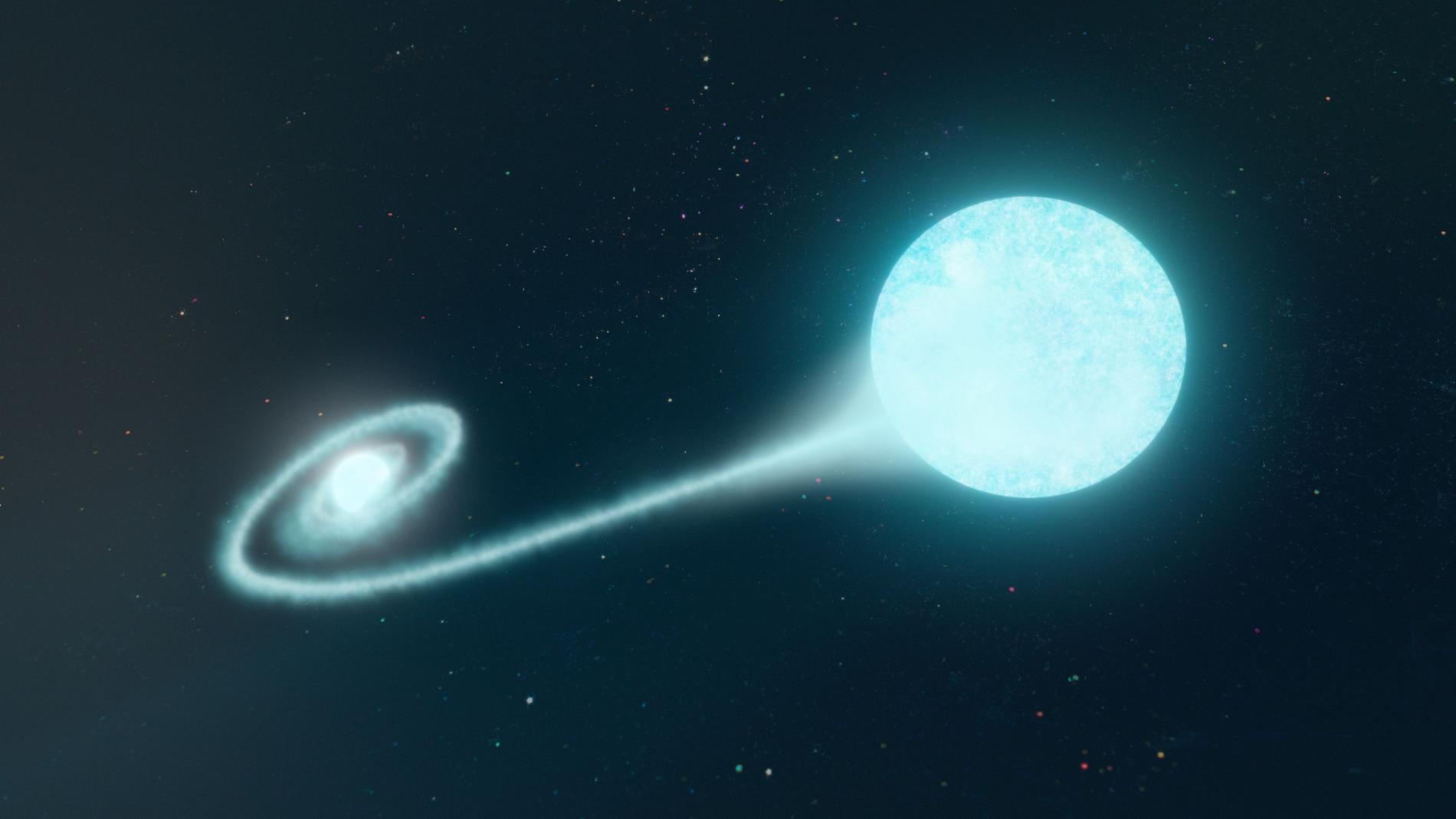
Artist's conception of the system that produced the supernova, in which a white dwarf star absorbs material from its companion star. Source: Adam Makarenko/W. M. Keck Observatory.
This work, whose contribution in radio data was led by the IAA-CSIC, has confirmed that the material expelled in the supernova explosion collided, after travelling sixty days, with the material surrounding the system, composed mostly of helium, which indicates that the companion star was not a white dwarf. Furthermore, models predicted that the radio emission, if present, would take many months to be detectable, and indeed the science team had to wait a year and a half to detect the supernova's radio counterpart.
“The unusual light curve of SN 2020eyj, the infrared emission, the detection of helium emission lines and the unprecedented radio detection make this supernova unique, a treasure of information with implications for multiple fields of research", says Miguel Pérez Torres, an IAA-CSIC researcher participating in the study. “Studying more similar systems will allow us to better understand the origin of these standard candles and the chemical evolution of galaxies”.
"Now that we have shown that radio observations can provide direct and unique information to understand this type of supernovae, it opens a path to study these systems with the new generation of radio instruments, such as the Square Kilometre Array Observatory (SKAO) in the future", concludes Javier Moldón (IAA-CSIC).
The result has been possible thanks to e-MERLIN, an array of very high angular resolution radio telescopes, and the analysis of the data has been carried out from the Spanish prototype of the SKA Regional Centre (SPSRC) of the IAA-CSIC, which is supported by the Severo Ochoa project of the IAA and which facilitates the processing of data from SKAO pathfinders, such as e-MERLIN.
[/et_pb_text][/et_pb_column] [/et_pb_row] [/et_pb_section]
Spain joins the SKA Observatory to participate in the construction of the largest radioastronomy facility on the planet
05/04/2023 – The Spanish contribution to the project, which amounts to 41.4 million euros until 2030, will allow Spanish companies to participate in contracts of high technological value for the construction of this scientific infrastructure. The Institute de Astrophysics de Andalusia (IAA-CSIC) is responsible for the technical coordination of the Spanish participation in the project.
The Council of Ministers has approved this Tuesday the accession of Spain as a full member of the SKA Observatory (SKAO), an intergovernmental organisation that is building two complementary world-class radiotelescopes that will constitute one of the largest and most ambitious scientific infrastructures on the planet.
The initial construction phase of the SKAO telescopes, covering the period from 2021 to 2030, will cost a total of 2,022 million euros. Spain will contribute a total of 41.4 million euros to this phase of the project, of which 7.9 million euros have already been paid between 2021 and 2022 (5.1 million euros from the Recovery, Transformation and Resilience Plan). In 2023, €2.5 million from the national budget is foreseen.
The formalisation of Spain's incorporation into the SKAO as a full member now allows Spanish companies to participate in the contracts for the construction of the two radiotelescopes, thanks to the principle of return that applies in this international organisation.
The participation of Spanish companies in at least five SKAO construction contracts is currently guaranteed. Spain will be responsible, for example, for the manufacture of the sub-reflectors (secondary mirrors) for the parabolic antennas and the production of the equipment for the time synchronisation of the radiotelescope receivers.
Spanish industry will thus increase its expertise in the many cutting-edge technologies and big data techniques that are indispensable for the operation of the SKAO and that are being developed specifically for this unique project.
Moreover, thanks to this adhesion, Spanish scientists will be able to carry out pioneering radio astronomical observations at the front line, which are destined to lead to transformational discoveries in the study of the universe.
"We are really grateful for the support of our SKAO colleagues over the years. It has been amazing to have reached this point, and we have thoroughly enjoyed the journey to get there working together with the Ministry, the CDTI and the astronomy community. Now we can move forward with even more challenging and exciting activities as part of the SKAO", declare Lourdes Verdes-Montenegro (IAA-CSIC), coordinator of the Spanish participation in SKAO.
SKAO telescopes: two innovative and revolutionary radiotelescopes
During the current construction phase, the member states of this intergovernmental organisation will agree on the contributions and the construction schedule for the next phase of the project.
The SKAO radio telescopes will consist of two arrays of hundreds of thousands of antennas of different types. The first array, dedicated to low-frequency antennas, will be located in the Murchison district of Western Australia, while the second, dedicated to medium and high frequencies, will be distributed in the Karoo Desert of South Africa.
When completed, the SKAO telescopes will be a colossal observatory: they will have tens of times the sensitivity, and thousands of times the observing speed, of the best radio astronomical facilities available today, and their performance will not be surpassed by any other radiotelescope for decades.
In addition to the scientific and technological challenges it will overcome, SKAO also faces an organisational and management challenge that is being addressed through close intergovernmental cooperation on a global scale, cooperation that will serve as a model for other large multinational projects.
Spain's participation in the SKA
Spain has been working on the design and preparatory tasks of the project since the 1990s together with the states that have already ratified the agreement establishing the SKAO - Australia, China, Italy, the Netherlands, Portugal, the United Kingdom, South Africa and Switzerland - and those that are in the process of ratifying it - Germany, Canada, South Korea, France, India, Japan and Sweden.
The technical coordination of the Spanish participation in the project is the responsibility of the Institute of Astrophysics of Andalusia (IAA-CSIC), which belongs to the Consejo Superior de Investigaciones Científicas (Spanish National Research Council), an agency of the Spanish Ministry of Science and Innovation, whose main role is to organise the national scientific community for its participation in the project.
There are currently astrophysicists from Spain involved in almost all the SKA science working teams, as well as in other groups, such as the energy supply options or the coordination of the regional centres.
WEAVE first light
13/12/2022 – The Institute of Astrophysics of Andalusia (IAA-CSIC) participates in the WEAVE scientific team, whose first observations already show the high quality of the data that the spectrograph will provide
WEAVE, a powerful state-of-the-art multifibre spectrograph installed on the William Herschel Telescope (WHT) at the Roque de los Muchachos Observatory (La Palma, Canary Islands), has obtained its first light. The instrument, whose scientific team includes the Institute of Astrophysics of Andalusia (IAA-CSIC), has obtained spectra of two of the galaxies in Stephan's Quintet, showing that WEAVE is already generating high-quality data.
The first observations were carried out with the so-called large integral field unit (LIFU) fibre bundle, one of WEAVE's three fibre systems in which 547 closely packed optical fibres transmit light in a hexagonal area of the sky to the spectrograph, where it is analysed and recorded.
The LIFU was aimed at NGC 7318a and NGC 7318b, two galaxies at the heart of Stephan's Quintet, a group of interacting galaxies. The group, 280 million light-years from Earth in the constellation Pegasus, is undergoing a major galaxy collision and provides a natural laboratory for the consequences of galaxy collisions on galaxy evolution. The spectra obtained by WEAVE reveal the motions of stars and gas, the chemical composition of the stars, the temperatures and densities of the gas clouds, among others, and provide insight into how galaxy collisions transform the galaxies in the group.
"Our goal was to host a unique instrument that would enable cutting-edge astronomical research. We are now pleased to demonstrate that the LIFU part of WEAVE not only works, but also produces high-quality data", says Marc Balcells, director of the Isaac Newton Group of Telescopes (ING) to which the telescope hosting WEAVE belongs. For his part, WEAVE principal investigator Gavin Dalton highlights "the wealth of complexity revealed by a single detailed observation of this pair of nearby galaxies, which provides an excellent illustration of the power and flexibility of WEAVE".
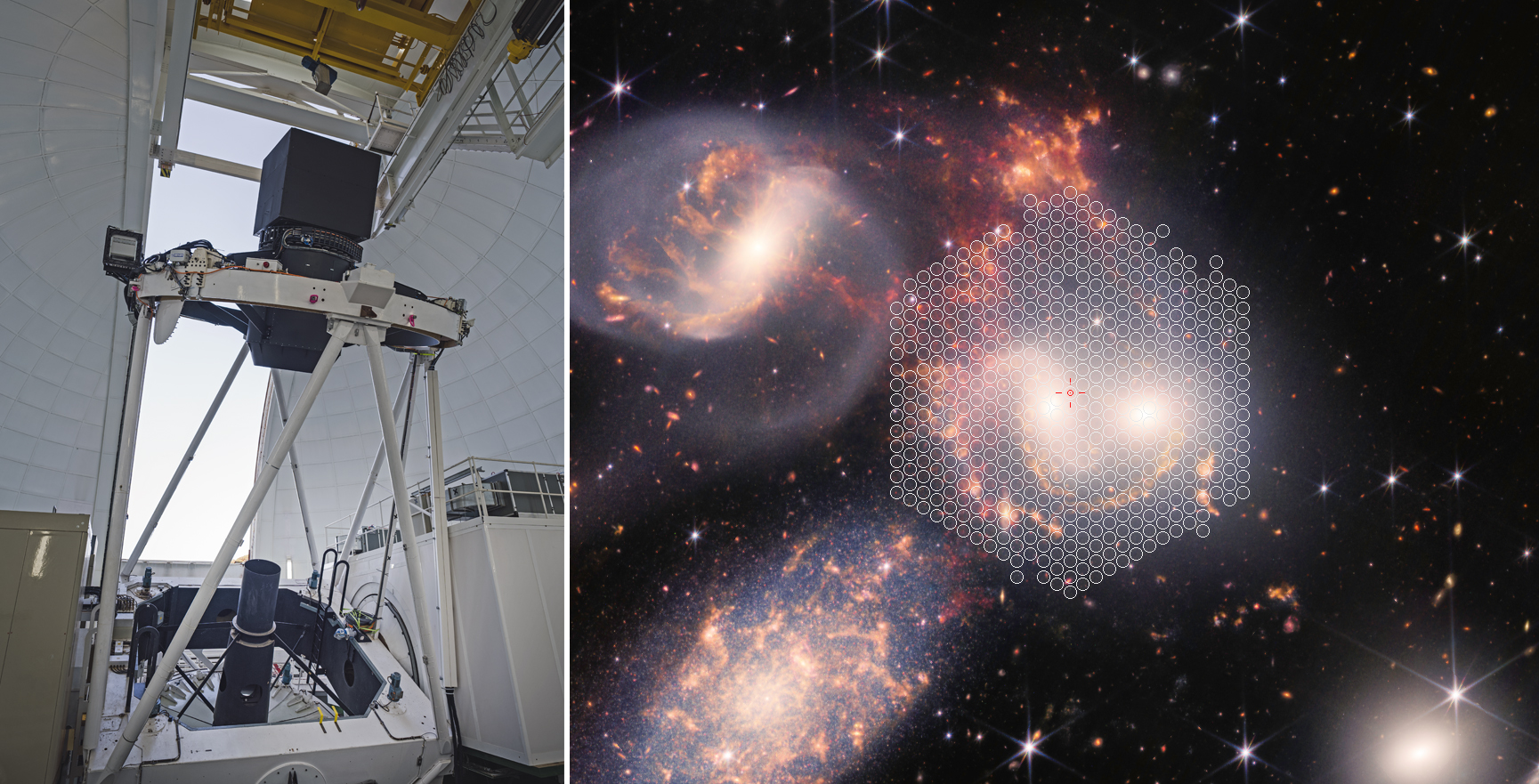
Left: The William Herschel Telescope with WEAVE. The WEAVE positioner is housed in the 1.8-metre black box above the top-end ring. Optical fibres run along the telescope structure to the light-gray enclosure on the left which houses the WEAVE spectrograph. Credit: Sebastian Kramer. Right: The JWST image with the WEAVE LIFU pointing at Stephan's Quintet for the first-light observation. The LIFU gathers light from 547 points on the sky for analysis by the WEAVE spectrograph (each circle indicates an optical fibre 2.6 arcseconds in diameter). The observation provides physical information from each separate region of each galaxy as well as the space in between. Credits: NASA, ESA, CSA, STScI (background image); Aladin (overlay with fibres).
WEAVE, A STATE-OF-THE-ART SPECTROGRAPH
WEAVE is a multi-mode, multi-fibre spectrograph built by a consortium of European astronomical institutions, led by the UK's Science and Technology Facilities Council, to become the next generation spectroscopic facility for the WHT.
WEAVE uses optical fibres to collect light from celestial sources and transmits it to a two-armed spectrograph. The spectrograph separates the light into its different wavelengths, or colours, and records them on large-format CCD light detectors. WEAVE's versatility is one of its greatest strengths. While the LIFU mode houses 547 tightly packed fibres to image large areas of the sky, in MOS mode up to 960 individual fibres can be placed separately using two robots to capture the light from many hundreds of stars, galaxies or quasars. In mIFU mode, the fibres are organised into 20 units, each consisting of 37 fibres, which are used to study small and large targets, such as nebulae and distant galaxies.
WEAVE also provides velocities along the line of sight through the Doppler effect. Depending on the science target, there is a choice between two spectral resolution powers: at low resolution, the spectra distinguish velocity differences of about 5 kilometres per second, and at high resolution of 1.2 kilometres per second. Even at its lowest power of resolution, WEAVE records the line-of-sight velocities of stars with accuracies similar to those of the transverse velocities measured by ESA's Gaia satellite.
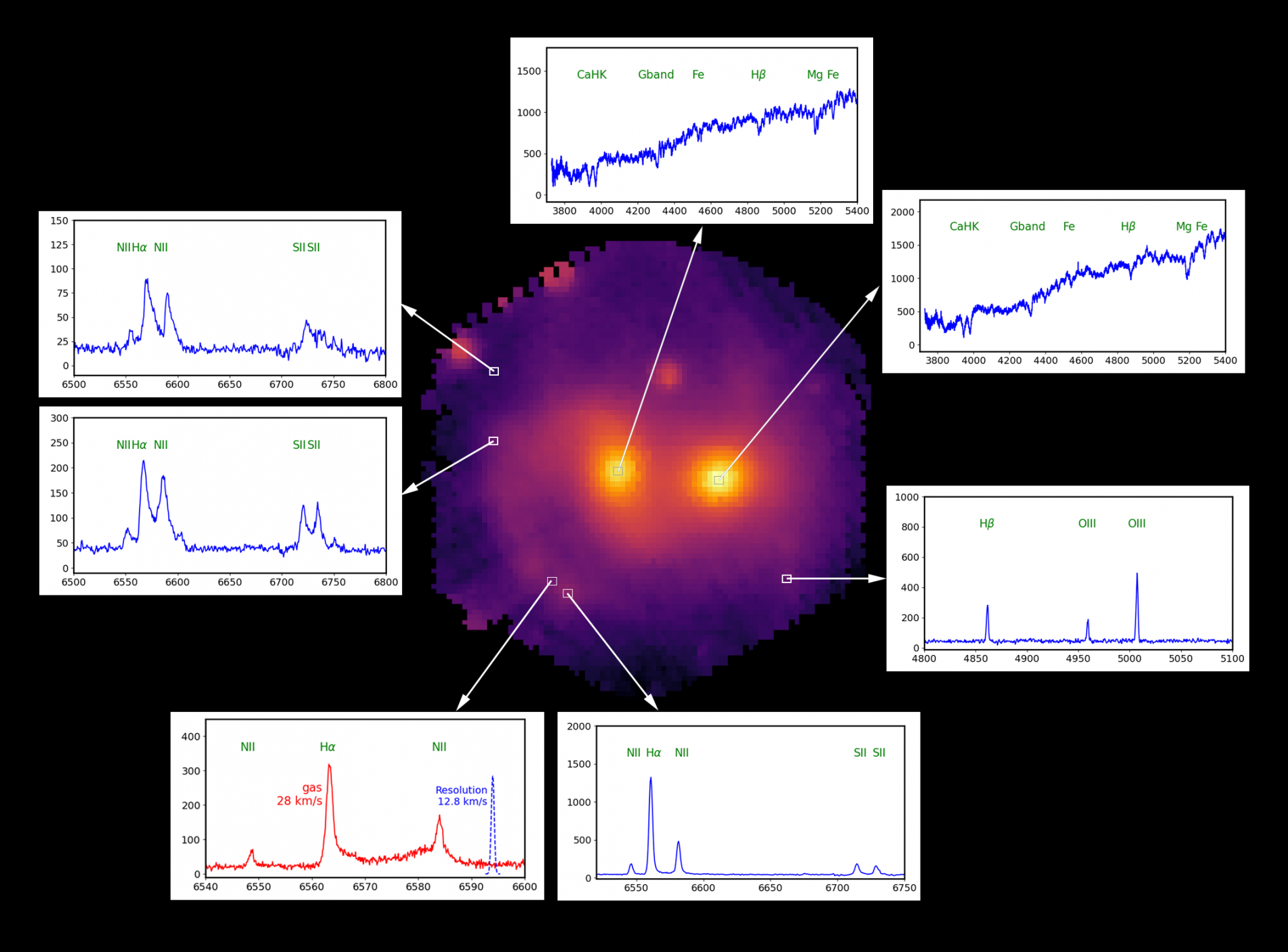
The advantage of the LIFU comes from the sheer amount of information contained in each observation. WEAVE produces spectra for each of 31,500 points or regions in and around the galaxies in two hours. The intensity of light from the fibres builds the image of the galaxies shown in the centre. The individual spectra (intensity at each wavelength; seven examples shown) provide a wealth of information about the physical conditions at each location. At the two galaxy nuclei (top-right) the spectra indicate moderately-old stars (one billion years) and no on-going star formation. The narrow, peaked spectra in the lower-right are typical of gas (hydrogen, oxygen, nitrogen, sulfur) heated to over 10,000 degrees by very young stars, whereas the broad, asymmetric peaks in the spectra shown on the left indicate turbulent shocks between gas clouds. WEAVE is particularly accurate at measuring wavelengths, or velocities. In the bottom-left panel (in red) obtained in the high spectral resolving power mode, velocity distributions as narrow as 12.8 km/s can be measured.
SCIENCE WITH WEAVE
Over the next five years, the ING will devote 70% of the time available at the WHT to eight large surveys with WEAVE, selected from those proposed by the astronomical communities of the partner countries. All of these surveys require spectra of up to millions of individual stars and galaxies, a goal made possible by WEAVE's ability to observe nearly a thousand objects at a time.
These surveys cover studies of stellar evolution, Milky Way science, galaxy evolution and cosmology. In synergy with the European Space Agency's Gaia satellite, WEAVE's MOS mode will be used to obtain spectra of several million stars in the disc and halo of our host galaxy, enabling the development of Milky Way archaeology. Nearby and distant galaxies, some detected by the LOFAR radiotelescope, will be studied for their growth history. And quasars will be used as beacons to map the spatial distribution and interaction of gas and galaxies when the universe was only about 20% of its present age.
The ING will also make 30% of the time available for projects competitively selected from among those proposed by astronomers in ING partner countries. These projects will take advantage of WEAVE's versatility to provide quick answers to immediate questions. There are also channels for programmes that jointly exploit WEAVE and the diverse capabilities of the telescopes of the Canary Islands Observatories such as the 10.4 metre Gran Telescopio Canarias.
WEAVE's construction has been funded by the Science and Technology Facilities Council (STFC, UK), the Netherlands Research School for Astronomy (NOVA, NL), the Dutch Science Foundation (NWO, NL), the Isaac Newton Group of Telescope (ING, UK/NL/ES), the Astrophysical Institute of the Canaries (IAC, ES), the Ministry of Economy and Competitiveness (MINECO, ES), the Ministry of Science and Innovation (MCI), the European Regional Development Fund (ERDF), the National Institute for Astrophysics (INAF, IT), the French National Centre for Scientific Research (CNRS, FR), Paris Observatory – University of Paris Science and Letters (FR), Besançon Observatory (FR), Region île de France (FR), Region Franche-Comté (FR), Instituto Nacional de Astrofísica, Óptica y Electrónica (INAOE, MX), National Council for Science and Technology (CONACYT, MX), Lund Observatory (SE), Uppsala University (SE), the Leibniz Institute AIP (DE), Max-Planck Institute for Astronomy (MPIA, DE), University of Pennsylvania (US), and Konkoly Observatory (HU).
Reference: Shoko Jin et al., 2022, "The wide-field, multiplexed, spectroscopic facility WEAVE: Survey design, overview, and simulated implementation", MNRAS, accepted for publication. http://arxiv.org/abs/2212.03981
The Ministry of Science and Innovation has earmarked 2.5 million euros for the international Square Kilometre Array radiotelescope
25/05/2022 – The Square Kilometre Array (SKA) will enable progress to be made in the search for signs of life in the galaxy and in the observation of pulsars, black holes and gravitational waves. The technical coordination of the Spanish participation in the project is carried out by the Institute de Astrophysics of Andalusia (IAA-CSIC)
The Council of Ministers has approved this Tuesday the agreements by which the Ministry of Science and Innovation will allocate 2.5 million euros to the international radiotelescope Square Kilometre Array (SKA), of which 0.7 million euros will come from the European funds of the Recovery, Transformation and Resilience Plan and will be devoted to the development of its instrumentation.
The SKA radiotelescope will consist of hundreds of thousands of antennas of different types, spread over different locations, ranging from the Karoo Desert in South Africa, which will host the core of high and medium frequency dishes, to the Murchison Shire in Australia, which will host the low frequency antennas.
The SKA will be thousands of times faster at observing the sky than the best radioastronomy facilities today and will enable astronomers to make sky observations in great detail, exceeding the image resolution quality of the Hubble space telescope by several orders of magnitude.
In this way, the SKA radio telescope will make ground-breaking contributions to astrophysics, astrobiology, fundamental physics, geophysics and geodesy. Among other functionalities, it will enable progress to be made in the search for signs of life in the galaxy and the observation of pulsars, black holes and gravitational waves.
Spain's participation in SKA
Our country has been participating in SKA since 2011 and has expressed its interest in participating as a full partner in the SKA observatory which, under the legal form of an international body, will be the entity responsible for carrying out the construction of the world's largest radiotelescope.
Part of the amount approved on Tuesday will be recognised by SKA as part of the agreed contribution with which Spain will become a full member.
The technical coordination of the Spanish participation in the project is the responsibility of the Institute of Astrophysics of Andalusia (IAA-CSIC), which belongs to the Consejo Superior de Investigaciones Científicas (Spanish National Research Council), an agency of the Spanish Ministry of Science and Innovation, whose main role is to organise the national scientific community for its participation in the project.
At present, astrophysicists from Spain are involved in almost all the science working teams of the SKA, as well as in other groups, such as the energy supply options or the coordination of the regional centres. In addition, a representative of the CDTI has been appointed to encourage Spanish industrial participation in SKA developments.
The most detailed images of galaxies are obtained thanks to LOFAR, a network of 70,000 antennas
27th August 2021 – The IAA-CSIC heads one of the eleven articles that make up a special issue of the journal Astronomy & Astrophysics on the results of LOFAR
After almost a decade of work, an international scientific team has published the most detailed images ever obtained of galaxies, which provide information about their internal workings in unprecedented detail. The images were created from data collected by LOFAR (Low Frequency Array), a network of more than 70,000 small antennas distributed throughout Europe. The images and the associated scientific results have been published in a special issue of the journal Astronomy & Astrophysics, one of them headed by the Institute of Astrophysics of Andalusia (IAA-CSIC).
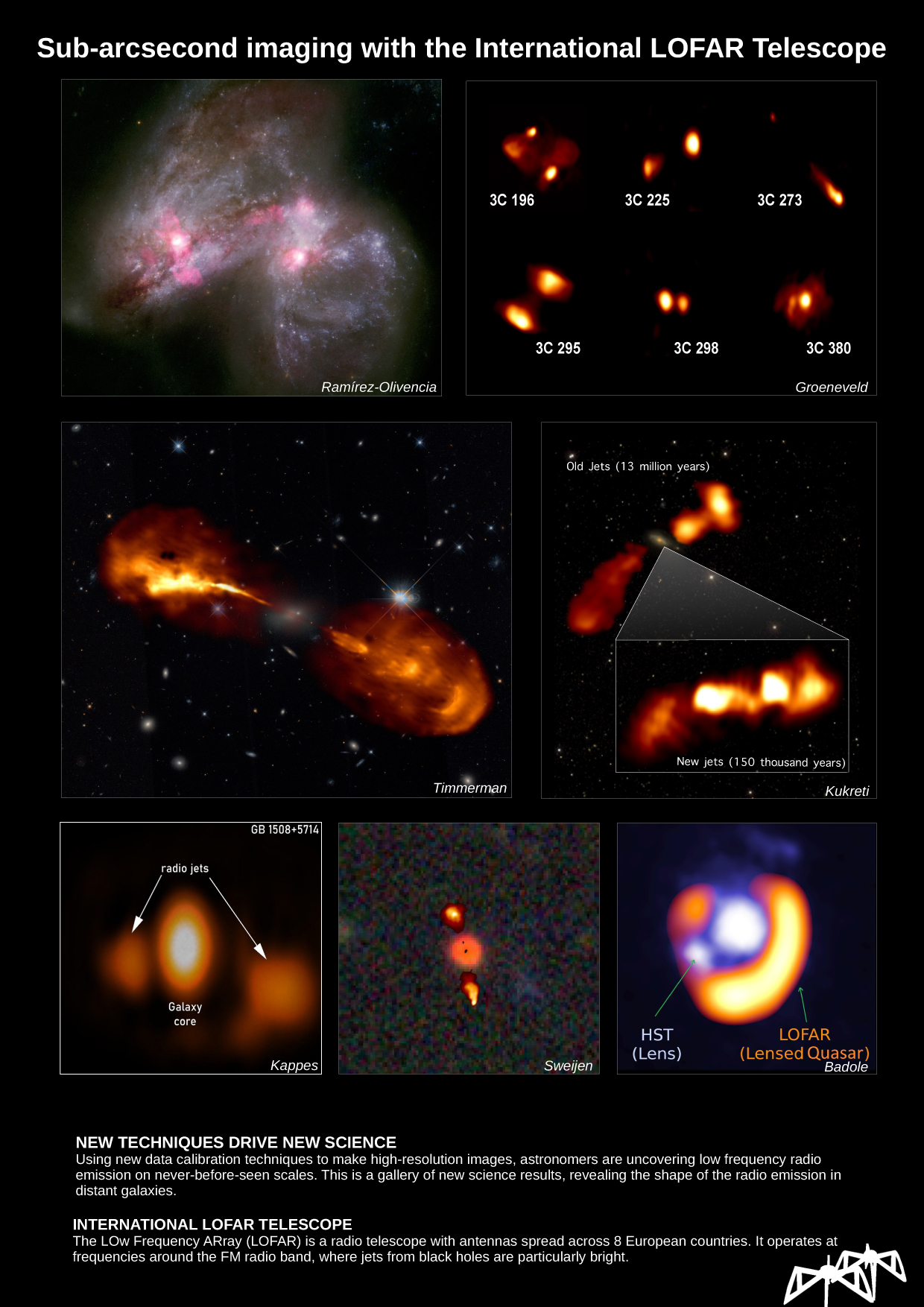
A compilation of the science results. Credit from left to right starting at the top: N. Ramírez-Olivencia et al. [radio]; NASA, ESA, the Hubble Heritage Team (STScI/AURA)-ESA/Hubble Collaboration and A. Evans (University of Virginia, Charlottesville/NRAO/Stony Brook University), edited by R. Cumming [optical], C. Groeneveld, R. Timmerman; LOFAR & Hubble Space Telescope,. Kukreti; LOFAR & Sloan Digital Sky Survey, A. Kappes, F. Sweijen; LOFAR & DESI Legacy Imaging Survey, S. Badole; NASA, ESA & L. Calcada, Graphics: W.L. Williams.
The universe is flooded with electromagnetic radiation, of which visible light, the one captured by our eyes, is only a small portion. From short wavelengths, like gamma rays and X-rays, to long wavelengths, like radio, each part of the spectrum of light reveals something unique about the universe.
The LOFAR network captures images at radio frequencies that, unlike shorter wavelength sources such as visible light, are not blocked by clouds of dust and gas that can obscure astronomical objects. Thus, regions of the sky that appear dark to our eyes glow brightly in radio waves, and radio telescopes allow us to observe areas obscured by dust, such as regions where stars form or the heart of galaxies.
The new images obtained with the LOFAR network go beyond the limits of what we know about galaxies and supermassive black holes. The images reveal the inner workings of both nearby and distant galaxies with a resolution twenty times sharper than typical LOFAR images, made possible by the unique way the team made use of the network.

This image shows real radio galaxies from Morabito et al. (2021). The gif fades from the standard resolution to the high resolution, showing the detail we can see by using the new techniques. Credit: L.K. Morabito; LOFAR Surveys KSP
The more than 70,000 LOFAR antennas are spread across Europe, with the majority in the Netherlands. In standard operation, only signals from antennas located in the Netherlands are combined and a virtual telescope is created with a collecting surface of about 120 kilometers in diameter. By using signals from all European antennas, the team has increased the diameter of the "lens" to nearly two thousand kilometers, providing a twenty-fold increase in resolution.
Furthermore, unlike conventional array antennas that combine multiple signals in real time to produce images, LOFAR uses a new concept in which the signals collected by each antenna are digitized, transported to the central processor, and then combined to create an image. Each LOFAR image is the result of combining the signals of more than 70,000 antennas, which makes its extraordinary resolution possible.
A CHALLENGE OF A DECADE
Even before LOFAR began operating in 2012, the European scientific team began to work on the colossal challenge of combining the signals of more than 70,000 antennas located at a distance of up to two thousand kilometers. "Our goal is that our work allows the international scientific community to use the entire European network of LOFAR telescopes for their own science, and to create high-resolution images with relative ease without having to spend years acquiring the knowledge," says Leah Morabito, researcher at Durham University who has coordinated the work.
The LOFAR results provide new perspectives on known galaxies, show their structure in detail and allow the detection of jets and ejections of material emerging from supermassive black holes in galactic nuclei. Specifically, the Institute of Astrophysics of Andalusia (IAA-CSIC) has contributed with a study of the galaxy Arp-299, which stands out for its high rate of supernova production, or explosions produced by the death of stars with more than eight times the mass of the Sun.
"At the IAA we have been investigating this galaxy for years, which due to the interaction with the companion galaxy is generating outbreaks of star formation -says Naím Ramírez-Olivencia, IAA researcher who heads the study-. It is, therefore, a very interesting object because it allows us to study in almost real time how stars are born, die and interact with the surrounding environment ".
"Our work has been chosen for this compendium of articles related to LOFAR because it is one of the first to show the capabilities of this wonderful instrument for low radio frequencies. Thanks to LOFAR we have managed to detect, for example, a gas outflow emanating from one of the nuclei of the Arp299 galaxy system, and with a scale comparable to the galaxy from which it emanates. Such a result has only been possible thanks to the great sensitivity and resolution of LOFAR, which in its current configuration constitutes a milestone in the astronomy and opens up a world of new discoveries", concludes the researcher.
Reference: List of LOFAR papers: https://www.astron.nl/wp-content/uploads/2021/08/papers1782021.pdf
MeerKAT discovers a group of galaxies hidden in a well-studied region
15th July 2021 – Its abundance in neutral hydrogen suggests that it is a group of galaxies in the process of formation
Most galaxies with intense star formation are contained within a cloud of cold neutral hydrogen, which acts as the fuel from which new stars will form. It is a diffuse, extremely faint gas that can only be detected at radio wavelengths and extends beyond the visible region of the galaxy. The observation of this gas allows us to understand the evolutionary processes that take place in galaxies, and a scientific team with the participation of the Institute of Astrophysics of Andalusia (IAA-CSIC) has found, with the MeerKAT radiotelescope, an ideal object of study: the group of galaxies richest in neutral hydrogen known.
"The distribution of neutral hydrogen in these galaxies has revealed interesting perturbed morphologies that suggest that the galaxies in the group influence each other. For example, we found a pair of interacting galaxies that will potentially merge to form a new galaxy with a completely transformed appearance", says Shilpa Ranchod, a researcher at the University of Pretoria who leads the study.
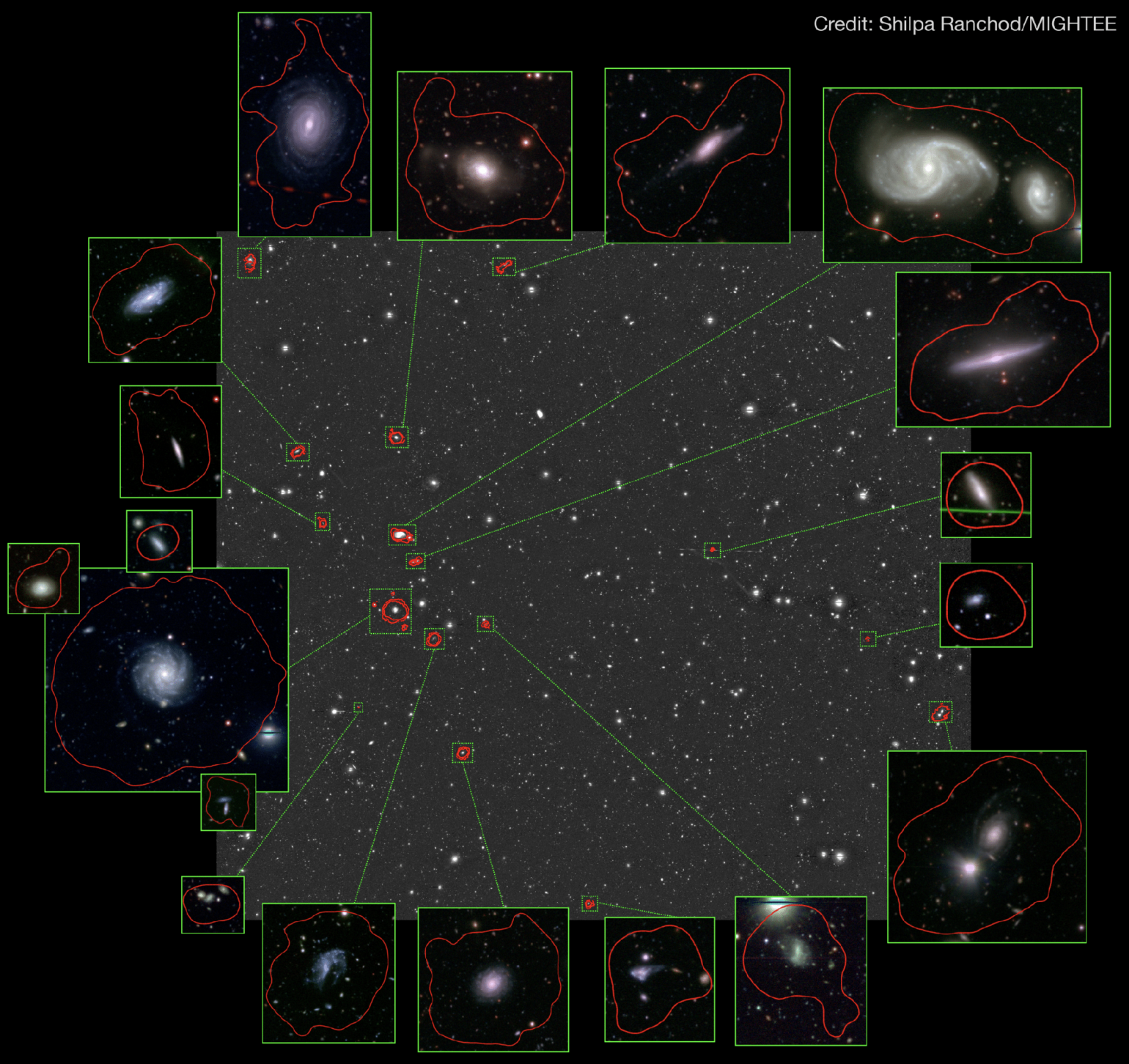
Image of the galaxy cluster with three-color optical images of each member galaxy using data from the Hyper-Suprime camera on the Subaru telescope. The red outline indicates the extent of neutral hydrogen around each galaxy. Credit: Shilpa Ranchod / Project MIGHTEE / HSC.
The discovery is part of the MIGHTEE (MeerKAT International Gigahertz Tiered Extragalactic Exploration) legacy project, one of the major surveys being developed with the MeerKAT telescope (South Africa) and involving an international science team. MeerKAT is the South African precursor to the Square Kilometre Array (SKA), which will be the largest scientific infrastructure on the planet, and aims to answer fundamental questions about the formation and evolution of galaxies. Its exceptional sensitivity provides a better understanding of the drivers of galaxy evolution.
This new group of galaxies lies in an area of the sky that has been studied in depth with other radiotelescopes, but only with MeerKAT has it been possible to observe the structure of the group so clearly. The environment of galaxies greatly affects how galaxies grow and evolve, and observations of neutral hydrogen with MeerKAT offer a new window into these structures.
"This is just a preview of what the MeeeKAT legacy project MIGHTEE will show us, and of the discoveries we will make with the SKA. This is a case of special interest for the line of research I coordinate at the IAA: unlike the dense groups of galaxies with a high deficiency in atomic gas with which we usually work and which, as we proposed, would be more evolved, in this case, a lot of gas has been detected, which suggests that we are dealing with a group in an early evolutionary phase, that is, a group in formation", says Lourdes Verdes-Montenegro, a researcher at the IAA who is participating in the study and coordinating the Spanish participation in the SKA.
This discovery will help to lay new foundations for understanding how galaxies assemble into groups and transform themselves through interaction with their environment. MeerKAT is an important step in the direction of the SKA, providing insight into future scientific projects and examples of how to overcome the many technical challenges involved in its full scientific potential.
Reference: S. Ranchod et al. "MIGHTEE-HI: Discovery of an HI-rich galaxy group at z = 0.044 with MeerKAT". Monthly Notices of the Royal Astronomical Society, July 2021. https://arxiv.org/abs/2107.01237
The largest radioastronomy observatory in the world, SKAO, is born
4th February 2021 –Spain is among the participating countries in the SKA Observatory (SKAO), an intergovernmental organization that will open a new era in radioastronomy. The Minister of Science, Pedro Duque, has highlighted that it is a milestone that will revolutionize astronomy and other scientific and technological fields. Spanish participation in SKA is led by the Institute of Astrophysics of Andalusia (IAA-CSIC)
Spain has participated this Thursday in the Council for the constitution of a new International Organization, which is the second dedicated to astronomy after the European Southern Observatory (ESO). The international radioastronomy observatory SKAO, which stands for Square Kilometer Array Observatory, is a new intergovernmental body that will be dedicated to the construction and operation, in South Africa and Australia, of the two largest and most complex radio telescopes conceived to date to study key questions about the universe.
During the last two decades, Spain has played an active role in the design phase of the Observatory with an important participation of the national scientific community in defining SKA science, an effort that has been included in a white paper on related scientific aspects with the new infrastructure published in 2015, and in which 120 scientists from more than 40 national institutions participated. In addition, our industry has played an important role, contributing to most of the infrastructure design consortia. All this estimated at approximately four million euros.
Spain's commitment for the construction of the Observatory is 41.4 million euros over the next ten years. Construction of the telescopes is expected to take eight years, with the first scientific results available in the middle of this decade. In addition to the advances that SKAO will bring to astronomy, its creation will be an important boost in many other areas, such as digital and communication technologies, supercomputing or big data, and will become a motor for the ecological transition and open science.
The Minister of Science and Innovation, Pedro Duque, has celebrated the constitution of the new observatory, underlining the involvement of Spain in the exhaustive study and design process. Likewise, he has highlighted that this is the beginning of a new stage for radioastronomy thanks to the construction of one of the most ambitious telescopes in the history of astronomy.

Artistic representation of SKA-Mid and SKA-Low. Credits: SKA Observatory
In addition, the minister stressed that Spain will actively participate in the new observatory, counting on a strategically positioned scientific community and a well-prepared industry.
Spanish participation in SKA is led by the Institute of Astrophysics of Andalusia (IAA-CSIC). Lourdes Verdes-Montenegro, IAA researcher and coordinator of Spanish participation in the SKA, celebrates this milestone: "Today is an exciting day, since for years the Spanish scientific and engineering community has been contributing to our participation in its first Council, which makes us witnesses of a milestone for the recent history of astronomy and positions us in the face of the key scientific projects of the SKA. SKAO shows a strong commitment to the Green Deal and Open Science, as well as to the promoting equality and inclusiveness, and brings us one step closer, through international cooperation, to the achievement of the United Nations Sustainable Development Goals". The SKA project and the development of the prototype of the "SKA Regional Center (SRC)" have the support of the management and the Severo Ochoa program of the IAA, of whose strategic plan they form a fundamental part.
MHONGOOSE begins to study the weak atomic gas that surrounds galaxies, key in their evolution
30th November 2020 – MHONGOOSE, a legacy project of the MeerKAT radiointerferometer, South African precursor to the Square Kilometer Array, produces its first results. They have been obtained in its preparatory phase, thus anticipating the window that will open to the understanding of the formation and evolution of galaxies.
MHONGOOSE (MeerKAT Observations of Nearby Galactic Objects - Observing Southern Emitters) is a legacy project to study the distribution of atomic hydrogen (HI) in a selection of nearby galaxies using the MeerKAT radiotelescope (South Africa). As part of its testing phase, it has already provided its first scientific results. This first work, published in the journal Astronomy and Astrophysics, provides new findings on the distribution of gas around the galaxy ESO 302-G014 and shows the potential of the project.

Aerial view of the MeerKAT interferometer under construction. Credit: SARAO.
MHONGOOSE will study how galaxies capture gas from their surroundings and the relationship between gas and star formation. To do so, the distribution of atomic hydrogen (HI) will be studied in a sample of 30 nearby galaxies, located less than 65 million light years from our Milky Way. The galaxies have been selected to cover all inclinations, from edge-on galaxies to front-on galaxies, and cover a very wide range in mass and luminosity.
This variety in the sample allows addressing various questions about the transformation and evolution processes of galaxies in the nearby universe. The project has obtained 1650 hours of observation in the MeerKAT radiointerferometer, a precursor of SKA (Square Kilometer Array) consisting of 64 antennas located in the Karoo desert, in South Africa. MeerKAT is, until SKA is built, the most efficient telescope to obtain the type of data that is needed in MHONGOOSE.
Gas Clouds Surrounding a Dwarf Galaxy in the Southern Hemisphere
The first results that MHONGOOSE provides correspond to the galaxy called ESO 302-G014, a nearby gas-rich dwarf galaxy. The international scientific team responsible for the work, which has the participation of the IAA-CSIC, has used observations made with MeerKAT, together with complementary data in other wavelengths, to study its evolutionary history. They have found that the galaxy has a thin, asymmetrical outer disk, as well as a tidal tail of atomic hydrogen and an isolated cloud about 6,500 light-years from this galaxy.
These structures, which had not been previously detected, seem to indicate that the galaxy underwent an interaction with another low mass galaxy. Lourdes Verdes-Montenegro, IAA-CSIC scientific researcher and the only Spanish member of the MHONGOOSE team, highlights that “the detected signs of a possible interaction with some low-mass galaxy companion are also supported by the presence of significant amounts of molecular gas detected by the ALMA interferometer and the existence of prominent star clusters, suggesting a recently induced star formation”.
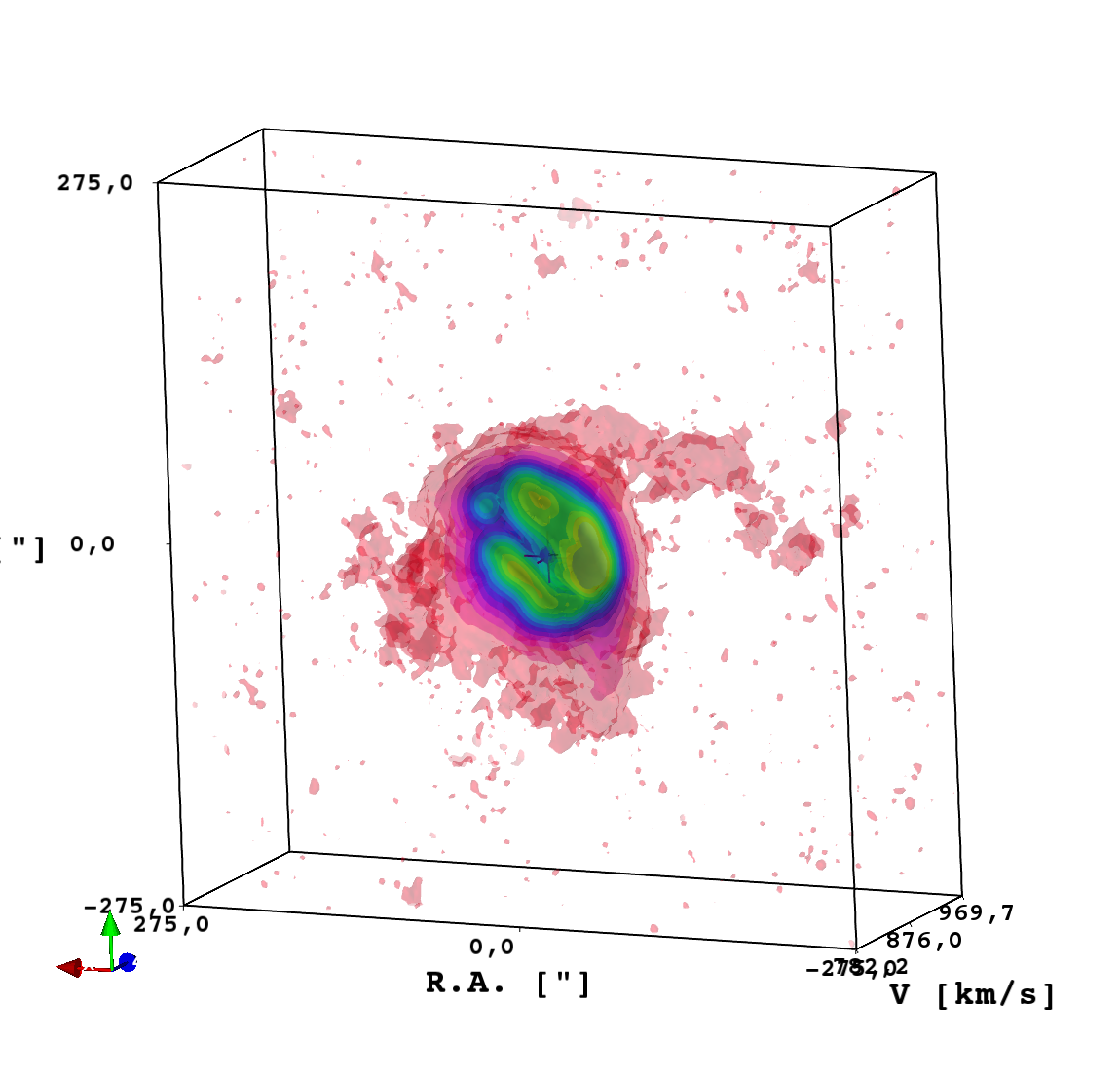
Emission of atomic hydrogen associated with the galaxy ESO 302-G014, represented in three dimensions, where the structure that could correspond to a possible interaction with a low-mass companion is shown. Credit: Lourdes Verdes-Montenegro (IAA-CSIC).
"The deep images from the Dark Energy Camera Legacy Survey show a faint and diffuse object near the end of the filament, whose radius, brightness and color are compatible with that of a dwarf galaxy at a distance similar to that of ESO 302-G014", points out Javier Román, a researcher at the IAA-CSIC expert in deep optical images who participates in the work.
These results are, according to Lourdes Verdes-Montenegro, “just a small preview of things to come”, as they have been obtained with preliminary observations, and she is confident that “in-depth observations of the objects in the MHONGOOSE sample will offer a glimpse of the fate of atomic gas when transferring from the intergalactic medium to galaxies”. In the medium-term future, these types of observations will be able to be extended to more distant galaxies thanks to SKA, which will be the largest radiotelescope in the world, and in which MeerKAT will be integrated to form a single interferometer.
de Blok et al. “MeerKAT HI commissioning observations of MHONGOOSE galaxy ESO 302-G014”. Astronomy & Astrophysics 643, A147 (2020) https://doi.org/10.1051/0004-6361/202038894
ESCAPE: Ciencia Abierta y nuevos caminos en el conocimiento del cosmos a todas las escalas
El proyecto ESCAPE engloba algunas de las mayores infraestructuras científicas mundiales en astronomía y física de partículas, para el desarrollo de una única plataforma digital para el uso abierto de datos.
Financiado con dieciséis millones de euros por la Unión Europea a través del programa Horizonte 2020, supone un esfuerzo único hacia la Ciencia Abierta.
El Instituto de Astrofísica de Andalucía (IAA-CSIC) contribuye al desarrollo de la “Plataforma de análisis científico”, por su papel fundamental en que la infraestructura astronómica Square Kilometre Array (SKA), sea un referente en metodología científica.
SKA fue identificado como Proyecto de Referencia en el Foro Estratégico Europeo sobre Infraestructuras de Investigación (ESFRI, por sus siglas en inglés) en 2016. Esta figura muestra las infraestructuras científicas ESFRI en astronomía, astropartículas y física de partículas que conforman el grupo de ESCAPE. En sentido de las agujas del reloj, de arriba abajo: ELT, CTA, FAIR, KM3NeT, EST, HL-LHC, SKA.
Las grandes infraestructuras europeas de astrofísica y de física de partículas se unen en el proyecto ESCAPE, que creará un Observatorio Virtual extendido a los dominios de la física solar, la física de partículas y las astropartículas. El proyecto responde así a un reto internacional que combina la gestión de las enormes cantidades de datos que producen proyectos como el LHC (Gran Colisionador de Hadrones) o el radiotelescopio SKA (Square Kilometre Array) con su disponibilidad en abierto para que la Nube de Ciencia Europea Abierta (EOSC) se haga realidad: una única plataforma que permita acceder, utilizar y analizar todos los datos científicos disponibles.
“El nombre ESCAPE fue elegido porque nuestra colaboración pretende dejar que los datos salgan de su confinamiento. Por primera vez, varias de las mayores instalaciones europeas en física y astronomía unen sus fuerzas para hacer que sus datos y software estén abiertos e interoperables. Es un gran hito para la investigación europea”, apunta Giovanni Lamanna, investigador del Laboratorio de Annecy de Física de Partículas (LAPP) e investigador principal del proyecto ESCAPE.
“Estamos viviendo un momento crucial, con el desarrollo de instrumentos cada vez más complejos, que producen enormes cantidades de datos y que requieren de software cada vez más especializado. En nuestro esfuerzo por ser mas eficientes en extraer conocimiento de dichos datos, corremos el riesgo de olvidarnos de la reproducibilidad de los resultados. Solo si somos capaces de cambiar la forma en que trabajamos los científicos podremos mejorar la calidad de la Ciencia, y el proyecto ESCAPE busca ofrecer soluciones, herramientas y servicios para ello”, señala Lourdes Verdes-Montenegro, investigadora del Instituto de Astrofísica de Andalucía (IAA-CSIC) que participa en el proyecto y que lidera la participación de España en el proyecto SKA.
El cosmos en abierto
Se espera un aluvión de datos en los próximos años gracias a las infraestructuras priorizadas en la hoja de ruta del Foro Europeo de Estrategia de Infraestructuras de Investigación (ESFRI, del inglés) entre las que destaca SKA, que constituirá la mayor infraestructura científica del mundo, el Cherenkov Telescope Array (CTA), el Telescopio Solar Europeo (EST), o el Telescopio Extremadamente Grande (ELT) y en misiones de la Agencia Espacial Europea como PLATO, que caracterizará los planetas orbitando en estrellas de nuestro entorno. En todas ellas participa el IAA, siendo objeto de su contribución a ESCAPE tanto SKA como PLATO.
La financiación asignada de dieciséis millones de euros contribuirá a que las principales infraestructuras de investigación europeas trabajen juntas para encontrar soluciones comunes a sus desafíos a nivel de datos, interoperabilidad y acceso a los mismos, así como para acentuar la apertura de la investigación fundamental a toda la comunidad internacional, desde profesionales hasta el público general.
La astronomía multimensaje (observaciones coordinadas de señales astrofísicas dispares) y la física de partículas con aceleradores son dos pilares del proyecto ESCAPE. A través de la combinación de investigación experimental de los dos extremos, desde las estructuras a gran escala en el universo observable hasta las partículas fundamentales, los proyectos relacionados con la astronomía y las instalaciones de física de partículas abrirán juntas nuevos caminos en el conocimiento del universo.
ESCAPE extenderá el concepto de observatorio astronómico virtual a la física solar, la física de partículas y las astropartículas. El proyecto explotará la dilatada experiencia de la comunidad de física de partículas y astrofísica en cálculo a gran escala y gestión de datos, construyendo nuevas herramientas para gestionar la avalancha de datos que producirá la nueva generación de instalaciones, creando una base de datos gigante con un tamaño superior a varios exabytes y federando centros de datos nacionales y regionales.
Se construirá una nueva plataforma de análisis científico, de manera que los usuarios de la Nube Europea de Ciencia Abierta puedan seleccionar software existente y utilizar el suyo propio, aprovechándose del potencial de la computación de alto rendimiento. Finalmente, ESCAPE creará un nuevo repositorio de software abierto para maximizar la reutilización y el desarrollo conjunto de software, identificar estándares abiertos para publicación de software e investigar herramientas de extracción de datos y nuevas técnicas de análisis. El plan de trabajo de ESCAPE hará también énfasis en la formación: el objetivo es atraer y educar a jóvenes científicos en ciencia abierta y administración de datos, utilizando las últimas herramientas y metodologías.
Participación del IAA-CSIC
El paquete de trabajo en el que participa el Instituto de Astrofísica de Andalucía (IAA-CSIC) “, se centra en la definición e implementación de la “Plataforma de análisis de ciencia ESFRI”, que servirá para el análisis de datos de acceso abierto en el entorno de la Nube Europea de Ciencia Abierta. “El IAA-CSIC contribuirá a crear una plataforma que dé apoyo a los investigadores en la creación de métodos reproducibles, mejorando así la manera de compartir, no solo los datos, sino también los métodos científicos -explica Lourdes Verdes-Montengro (IAA-CSIC), coordinadora de la participación de España en SKA -. Es un momento clave, al coincidir con el inicio de la creación de un centro regional piloto para SKA en el IAA, asociado a su acreditación como Centro de Excelencia Severo Ochoa. Como coordinadora del desarrollo considero fundamental seguir los principios de Ciencia Abierta, y por tanto la transversalidad con otras líneas desarrolladas en el centro, como la participación en la misión espacial PLATO.
Forman parte de este consorcio proyectos ESFRI como el Cherenkov Telescope Array (CTA), el Extremely Large Telescope (ELT), el Telescopio Solar Europeo (EST), el Facility for Antiproton and Ion Research in Europe (FAIR), el High Luminosity-Large Hadron Collider (HL-LHC), el Cubic-kilometre-sized Neutrino Telescope (KM3NeT) y el Square Kilometre Array (SKA). Dos organizaciones paneuropeas, la European Organization for Nuclear Research (CERN) y el European Southern Observatory (ESO), también son miembros de la agrupación ESCAPE. El European Virtual Observatory (EURO-VO) también está comprometido de manera activa con el proyecto. ESCAPE engloba otros observatorios astronómicos de primera línea mundial, tales como los operados por ESO (APEX ALMA, los observatorios de Paranal y La Silla), infraestructuras de investigación tales como el European Gravitational-Wave Observatory (EGO-Virgo) y el Joint Institute for VLBI ERIC (JIV-ERIC).
Lista completa de miembros de ESCAPE
(señalados en negrita los miembros españoles del proyecto)
Centre National de la Recherche Scientifique (CNRS), European Organization for Nuclear Research (CERN), ASTRON, CWI and NIKHEF institutes of the Stichting Nederlandse Wetenschappelijk Onderzoek Instituten (NWO-I), Friedrich-Alexander-Universität Erlangen- Nürnberg (FAU), European Southern Observatory (ESO), The Square Kilometre Array Organization (SKA), Facility for Antiproton and Ion Research in Europe (FAIR GMBH), Koninklijke Sterrenwacht van Belgie (ORB), Università degli Studi di Roma Torvergata (UNITOV), Leibniz-Institut für Astrophysik Potsdam (AIP), Istituto Nazionale d’Astrofisica (INAF), Instituto de Fisica de Altas Energias (IFAE), Stiftung Deutsches Elektronen-Synchrotron (DESY), Universidad Complutense de Madrid (UCM), Max-Planck-Gesellschaft zur Förderung der Wissenschaften EV (MPG), Stiftung Kiepenheuer-Institut für Sonnenphysik (KIS), Ruprecht-Karls-Universität Heidelberg (UHEI), GSI Helmholtzzentrum für Schwerionenforschung Gmbh (GSI), The University of Edinburgh (UEDIN), Istituto Nazionale di Fisica Nucleare (INFN), Joint Institute for Very Long Baseline Interferometry, a European Research Infrastructure Consortium (JIV-ERIC), European Gravitational Observatory / Osservatorio Gravitazionale Europeo (EGO), The Open University (OU), Agencia Estatal Consejo Superior de Investigaciones Cientificas (CSIC), Instituto Nacional de Tecnica Aeroespacial Esteban Terradas (INTA), HITS GGMBH (HITS), Cherenkov Telescope Array Observatory GGMBH (CTAO GGMBH), Rijksuniversiteit Groningen (RUG), Surfsara BV, TRUST-IT Services (TRUST-IT), OROBIX Srl (OROBIX).
Sobre SKA
El proyecto Square Kilometre Array (SKA) es un esfuerzo internacional para construir el radiotelescopio más grande del mundo, liderado por la Organización de SKA, situada en el Observatorio de Jodrell Bank, cerca de Manchester. El SKA llevará a cabo ciencia transformacional para mejorar nuestro entendimiento del Universo y las leyes fundamentales de la física, observando el cielo con un detalle sin precedente y trazando un mapa celeste cientos de veces más rápido que cualquier instalación actual.
El SKA no es un único telescopio, sino una colección de telescopios, llamados array (conjunto), distribuidos a lo largo de grandes distancias. El SKA se construirá en Australia y Sudáfrica, expandiéndose después por ambos países y por los continentes de África y Oceanía.
Con el apoyo de 12 países (Australia, Canadá China, España, Francia, India, Italia, Nueva Zelanda, Sudáfrica, Suecia, Países Bajos y Reino Unido), la Organización de SKA ha reunido en el diseño y desarrollo del telescopio a algunos de los mejores científicos, ingenieros y responsables políticos del mundo y a más de 100 empresas e instituciones de investigación.
España se convierte en el undécimo país miembro de SKA
Sede de SKA, 19 de junio de 2018 – España se ha convertido en el undécimo miembro de la Organización del Square Kilometre Array (SKA). Culminan así varios años de trabajo de la comunidad científica española, encaminado a participar en el desarrollo y explotación de un instrumento que protagonizará los grandes hallazgos de las próximas décadas.
El ministro de Ciencia, Innovación y Universidades, Pedro Duque, ha asegurado que la adhesión de España a la organización SKA «es una inversión estratégica para nuestro país, ya que el Observatorio SKA será una de las infraestructuras internacionales de investigación más importantes de Europa en los próximos años». El ministro ha explicado que la pertenencia a la organización internacional permitirá explorar la forma de «participar en la futura construcción del Observatorio SKA en las mejores condiciones, garantizando que los científicos españoles tengan acceso a las mejores infraestructuras de radioastronomía a gran escala y que nuestra industria de vanguardia esté bien posicionada para competir en los contratos de desarrollo de tecnologías y de construcción».
Catherine Cesarsky, presidenta del Consejo Directivo de SKA, ha asegurado que la organización está «encantada de dar la bienvenida a España. Su participación en los últimos años ha sido sustancial, por lo que la adhesión parecía un paso natural. Esperamos trabajar con España aún más de cerca en los próximos años, a medida que avancemos en la construcción y operación de los telescopios».
La participación española en SKA ha estado liderada por el Instituto de Astrofísica de Andalucía (IAA) de la Agencia Estatal Consejo Superior de Investigaciones Científicas (CSIC). Lourdes Verdes-Montenegro, investigadora del IAA, ha celebrado la noticia y ha explicado que durante muchos años España «ha tenido una gran participación en SKA, tanto desde el punto de vista científico como de la industria. El SKA revolucionará nuestra forma de ver el Universo y España formará parte de este reto».
España ha estado participando en actividades relacionadas con SKA desde sus comienzos y muchos científicos e ingenieros han participado en diferentes grupos de trabajo de ciencia e ingeniería de SKA desde 2012, fecha en que se creó la organización SKA para dirigir el proyecto durante la fase de diseño del telescopio.
En la actualidad, 26 investigadores españoles forman parte de 9 de los 11 grupos de trabajo de ciencia de SKA. Y en 2015, 120 investigadores españoles de 40 instituciones participaron en la redacción del Libro Blanco español de SKA.
Desde el punto de vista de la ingeniería, 11 centros de investigación españoles y 12 empresas contribuyen al diseño de SKA, participando en 8 consorcios internacionales (incluidos Dishes, Signal & Data Transport, Central Signal Processor, Science Data Processor, Telescope Manager, Infrastructure y Phased Array Feeds).
Sobre SKA
El proyecto Square Kilometre Array (SKA) es un esfuerzo internacional para construir el radiotelescopio más grande del mundo, liderado por la SKA Organisation, situada en el Observatorio de Jodrell Bank, cerca de Manchester. El SKA llevará a cabo ciencia transformacional para mejorar nuestro entendimiento del Universo y las leyes fundamentales de la física, observando el cielo con un detalle sin precedente y trazando un mapa celeste cientos de veces más rápido que cualquier instalación actual.
El SKA no es un único telescopio, sino una colección de telescopios o instrumentos, llamados array (conjunto), distribuidos a lo largo de grandes distancias. El SKA se construirá en dos fases. La Fase 1 (SKA1) en Sudáfrica y Australia y la Fase 2 (SKA2), en la que se expandirá a otros países del continente africano, así como la expansión de la componente australiana.
Con el apoyo de 11 países miembros (Australia, Canadá China, España, India, Italia, Nueva Zelanda, Sudáfrica, Suecia, Países Bajos y Reino Unido), la SKA Organisation ha reunido en el diseño y desarrollo del telescopio a algunos de los mejores científicos, ingenieros responsables políticos del mundo y a más de 100 empresas e instituciones de investigación a lo largo de 20 países. El comienzo de la construcción de SKA está previsto para 2021, esperando las primeras observaciones a mediados de la década de 2020.
Noticia original: https://www.skatelescope.org/news/spain-joins-skao/
El SKA o… qué tienen que ver Einstein, Jodie Foster y 300 ingenieros
El sábado 14 de abril, a las 12:00h, en el Centro de Ciencia PRINCIPIA de Málaga, Lourdes Verdes-Montenegro explicará de nuevo la curiosa relación entre Einstein, Jodie Foster y 300 ingenieros.
El Square Kilometre Array será un radiointerferómetro compuesto por cientos de miles de antenas distribuidas en Australia y África, que sumarán una superficie equivalente de un kilómetro cuadrado (de ahí su nombre: Square Kilometre Array, SKA). Sus características y precisión permitirán grandes avances en la astrofísica, la astrobiología y la física fundamental, áreas de gran interés en los centros de astrofísica de España.
En esta charla, Lourdes Verdes-Montenegro nos contará cuáles son las preguntas clave que requieren de un radiotelescopio como SKA para ser respondidas, de los retos científicos a los que se enfrenta la astronomía hoy en día, del impacto social que supondrá el desarrollo de este radiotelescopio así como de los pasos que se están llevando a cabo para su diseño y posterior construcción.
De estas cosas, y de que científicos, ingenieros y divulgadores de la ciencia españoles no se han quedado esperando a que los vientos sean favorables para involucrarse en el primer proyecto a escala terrícola de la historia, se hablará mañana en la Sala Faraday del Centro de Ciencia PRINCIPIA.
Un congreso en Valencia reunirá a científicos de diferentes áreas para debatir las capacidades del SKA
El congreso Oportunidades Físicas con una nueva visión del Universo: el radiotelescopio SKA, que se celebrará en el Instituto de Física Corspuscular de Valencia, durante los días 6 y 7 de noviembre, reunirá a científicos de campos como la Astrofísica, la Astrobiología y la Física de partículas para debatir las capacidades de esta futura instalación internacional.
Además, contará con la presencia de la Secretaria de Estado de Investigación, Desarrollo e Innovación, Carmen Vela, así como del Presidente del CSIC, Emilio Lora-Tamayo, el Director General del SKA, Philip Diamond, y el Rector de la Universidad de Valencia, Esteban Morcillo, entre otras autoridades.
Más información sobre esta noticia en http://www.iaa.es/noticias/el-radiotelescopio-ska-abrira-nuevas-posibilidades-al-estudio-universo
Como parte de estas jornadas, la tarde del día 6 de noviembre, a las 19:00, Lourdes Verdes-Montenegro, coordinadora de la participación española en el proyecto SKA, dará una charla divulgativa abierta al público en el Museo de las Artes y las Ciencias.
Para conocer toda la información sobre el congreso, visita la web: http://riastronomia.es/physics-opportunities-with-new-universes-view-the-ska-radio-telescope/
El IAA-CSIC acoge del 16 al 20 de octubre varias reuniones sobre los SRCs de SKA
Con motivo de la celebración en el Instituto de Astrofísica de Andalucía (IAA-CSIC) de una reunión del proyecto H2020 AENEAS, para el desarrollo de una Red Europea de Centros de Datos del Square Kilometre Array, se celebrarán en el IAA varias reuniones más relacionadas con el proyecto SKA.
Será una semana muy interesante para los participantes de todas las reuniones, ya que se reunirán en Granada miembros del Grupo de Coordinación de Centros Regionales del SKA, miembros del proyecto SKA-Link y miembros del proyecto AENEAS.
Como parte de las jornadas, el investigador principal del proyecto AENEAS dará una conferencia sobre cómo la Red de Centros Regionales del SKA constituirá una plataforma para realizar la ciencia del SKA y la astronomía de forma global. Además, el jefe de la red de computación del Gran Colisionador de Hadrones (LHC) hablará sobre el reciente acuerdo de colaboración firmado entre el SKA y el CERN (Organización Europea para la Investigación Nuclear).
Toda la información sobre las reuniones que tendrán lugar la puedes encontrar en la web del IAA-CSIC
La Noche de l@s Investigador@s también contó con el SKA
El pasado viernes 29 de septiembre tuvo lugar en Granada y en cientos de ciudades europeas, la Noche europea de l@s investigador@s, un evento altamente divulgativo que aúna a investigadores y público bajo las mismas carpas para dar a conocer las actividades científicas que se están llevando a cabo en los centros de investigación de cada ciudad. Esta forma de acercar la ciencia al público general de una forma práctica y divertida va ya por su séptimo año consecutivo en nuestro país y cada vez tiene más éxito.
La Noche Europea de l@s Investigador@s es un proyecto europeo de divulgación científica promovido por la Comisión Europea dentro de las acciones Marie Sktodowska-Curie del programa Horizonte 2020, que tiene lugar simultáneamente en más de 250 ciudades europeas desde 2005.
En esta ocasión, y por segunda vez consecutiva, la Coordinadora de la participación española en el SKA, Lourdes Verdes-Montenegro, presentó SKA a los granadinos de una manera amena y sencilla, con la charla «El Square Kilometre Array o… ¿Qué tienen que ver Einstein, Jodie Foster y 300 ingenieros?».
Esta actividad ha reunido en Granada a más de 300 investigadores que, mediante monólogos, charlas divulgativas, demostraciones en directo, talleres, etc., han podido transmitir una pequeña parte de sus conocimientos a la ciudadanía, dando así a conocer qué beneficios aportan a la sociedad y cómo estos se ven reflejados en su día a día.
La participación española en la ciencia y diseño del proyecto internacional SKA se presenta en la XII Reunión Científica de la SEA
Bilbao, 19 de julio de 2016 – El Square Kilometre Array (SKA), que será el mayor radiotelescopio del mundo y cuenta con gran involucración de la comunidad astronómica española, ha protagonizado una de las sesiones plenarias de esta reunión científica que se celebra anualmente en España.
La XII Reunión Científica de la Sociedad Española de Astronomía que se celebra estos días en Bilbao tiene en la instrumentación del futuro para la observación astronómica uno de los temas principales, con especial énfasis en la participación científica y tecnológica española. En concreto en el SKA, que una vez construido será el radiotelescopio más sensible del mundo.
En la sesión plenaria sobre el SKA han participado Philip Diamond, Director General de la Organización del SKA que lidera el proyecto; Lourdes Verdes-Montenegro, investigadora del Instituto de Astrofísica de Andalucía (IAA-CSIC) y coordinadora de la participación de España en el SKA; el investigador del Instituto de Física de Cantabria (IFCA-CSIC), Diego Herranz, y los investigadores del IAA-CSIC Ivan Agudo, Miguel Ángel Pérez Torres y Guillem Anglada.
Phil Diamond, Director General de la SKA Organisation ha sido invitado a la Sesión Plenaria del SKA en el XII encuentro bienal de la Sociedad Española de Astronomía, celebrada en Bilbao el 19 de julio de 2016. En dicha sesión dio una charla acerca del estatus actual del proyecto SKA.
Un proyecto de vanguardia
El Square Kilometre Array (SKA) será la mayor infraestructura científica construida sobre la Tierra. SKA es un conjunto de cientos de miles de antenas que se instalará en Sudáfrica y Australia –está previsto que la construcción comience en 2018– y será el radiotelescopio más sensible jamás construido, lo que supone un enorme reto tecnológico que abrirá las puertas a nuevos descubrimientos científicos. Entre ellos destacan el estudio de las primeras etapas del universo y la formación de las primeras estrellas, la física de los púlsares y de las ondas gravitacionales, la naturaleza de la materia y energía oscuras, y la búsqueda de vida en otros planetas a través de trazas moleculares y de potenciales inteligencias extraterrestres a través de señales de radio, según ha expuesto el profesor Philip Diamond, Director General de la Organización SKA que lidera el proyecto.
Participación española en SKA
La participación de España en actividades relativas al SKA se inició en la década de 1990 y “desde 2012 las actividades se han intensificado, bajo la coordinación del Instituto de Astrofísica de Andalucía (IAA-CSIC). Actualmente 21 investigadores de 8 centros españoles diferentes participan en 7 de los 11 Grupos de trabajo científicos de SKA. En el ámbito tecnológico, participan más de 20 centros de investigación y empresas de tecnología españolas”, ha señalado Lourdes Verdes-Montenegro, investigadora del Instituto de Astrofísica de Andalucía (IAA-CSIC) y coordinadora de la participación de España en el SKA.
“Científicos e ingenieros españoles vienen trabajando fuertemente para conseguir posicionar estratégicamente a nuestro país y lograr el máximo retorno científico del SKA, así como para contribuir en paquetes de trabajo de relevancia tecnológica y alto potencial de innovación. Este esfuerzo podría ser aprovechado si España se convierte en miembro de pleno derecho antes de que comience la construcción de la que será la mayor infraestructura científica sobre la Tierra”, ha destacado Lourdes Verdes-Montenegro. Actualmente la Organización del SKA está formada por diez países: Australia, Canadá, China, India, Italia, Nueva Zelanda, Sudáfrica, Suecia, Países Bajos y Reino Unido, siendo España país Observador.
La ciencia y la tecnología que están por venir
“Muchas de las incógnitas aún no resueltas de la cosmología moderna, tales como la naturaleza de la materia y la energía oscura, que dominan la dinámica del Universo, podrán ser estudiadas en profundidad por el SKA”, ha expuesto Diego Herranz (IFCA-CSIC) en su conferencia Amanecer cósmico, época de reionización y sinergias con radiación de Fondo Cósmico de Microondas . Ha afirmado también que “la comunidad astronómica española tiene un gran interés en participar activamente en el desarrollo de la ciencia que se lleve a cabo con el SKA, así como la experiencia suficiente para jugar un papel fundamental dentro de este proyecto internacional”.
Iván Agudo (IAA-CSIC) ha centrado su conferencia Núcleos Galácticos Activos en longitudes de ondas de radio en las posibilidades que ofrece el SKA respecto al estudio de los Núcleos Galácticos Activos (AGN en sus siglas en inglés). Agudo explicó que “los AGN son las fuentes de radiación duradera más potentes conocidas hasta ahora. Pueden eclipsar a las galaxias que los albergan y producir, a partir de sus agujeros negros supermasivos centrales, potentes chorros que se alejan a grandes velocidades y que radian enormes cantidades de radiación en todo el espectro electromagnético”. Agudo afirmó que el SKA, gracias a su sensibilidad sin precedentes, permitirá dar un salto de gigante en este campo.
Otra de las novedades que ofrece el SKA, será hacer observaciones simultáneas de porciones del cielo con una capacidad de discernir detalles y una profundidad que no se han conseguido hasta el momento. Miguel Ángel Pérez Torres (IAA-CSIC) expuso en su charla Supernovas y Galaxias cercanas normales y luminosas en el infrarrojo que “las observaciones con SKA darán acceso a un mejor entendimiento de la formación estelar y los procesos de acreción de materia en el Universo cercano, gracias al estudio de un amplio número de galaxias próximas”.
Por último, Guillem Anglada (IAA-CSIC) centró su conferencia Discos protoplanetarios, chorros y el nacimiento de las estrellas en explicar el proceso de formación planetaria que tiene lugar en discos de polvo y gas alrededor de estrellas jóvenes, y cómo el SKA será una herramienta clave al poder hacer observaciones con un detalle sin igual de este tipo de los discos. Aunque los interferómetros VLA y ALMA ya han observado estos discos, el SKA mejorará la resolución espacial de las imágenes, con lo que podremos entender mejor este proceso de formación.
Esta sesión plenaria durante la SEA convocó a un gran número de asistentes, que mostraron su interés por el proyecto SKA.
SKA Industry day en Madrid
Instituto de Astrofísica de Andalucía, Granada, 22 de Febrero de 2016.
Mañana, 23 de Febrero de 2016 tendrá lugar en Madrid, la jornada informativa “Square Kilometre Array (SKA) Industry Day”. Esta jornada ha sido organizada por el Instituto de Astrofísica de Andalucía (CSIC), que coordina la participación de España en el SKA (IP. Lourdes Verdes-Montenegro), en colaboración con el Centro para el Desarrollo Tecnológico Industrial (CDTI), en cuya sede se celebrará el acto. El objetivo de dicha jornada es informar a los representantes de las empresas españolas, junto con grupos tecnológicos de instituciones académicas, relacionados con los sectores de energías renovables, telecomunicaciones, sistemas mecánicos, electrónica, etc… sobre el estatus actual del Square Kilometre Array (SKA), así como de los posibles campos en los que las empresas españolas podrían colaborar en el diseño e implementación de este colosal instrumento. El SKA, cuya construcción está prevista para el año 2018, será una vez terminado la mayor infraestructura científica jamás creada. Sus cientos de miles de antenas, distribuídas en superficie de miles de kilómetros tanto en África como Oceanía, darán lugar a ciencia revolucionaria en el campo de la física fundamental, la cosmología y la astrofísica. Supone, además, un desafío a nivel tecnológico, tanto de ingeniería como de gestión, por lo que se espera que a partir de su desarrollo y explotación surjan muchas aplicaciones directas.
El SKA, el mayor radiotelescopio del mundo, será un motor para la ciencia española e internacional
El interés de científicos de diversas áreas ha quedado plasmado en el Libro Blanco Español, que muestra el enorme potencial de SKA para la ciencia española, y en el Advancing Astrophysics with the Square Kilometre Array
El mayor radiotelescopio del mundo, que en marzo de este año fijaba su diseño definitivo, constituye un desafío que generará tanto innovación tecnológica como sorprendentes avances científicos. En este sentido se han dado dos pasos importantes, con la publicación del Advancing Astrophysics with the Square Kilometre Array y del Libro Blanco Español, publicaciones que ponen de manifiesto las posibilidades para la ciencia española e internacional respectivamente de este revolucionario proyecto.
“El Libro Blanco Español del SKA, fruto del esfuerzo de 119 astrónomos de 40 diferentes centros de investigación, muestra el gran interés de los investigadores españoles por el SKA” apunta Miguel Ángel Pérez-Torres, investigador del Instituto de Astrofísica de Andalucía (IAA-CSIC) que coordinó la edición. “Este libro representa un hito en los esfuerzos de toda la comunidad astronómica, cuyo objetivo reside en que nuestro país pase a formar parte de pleno derecho de este instrumento”.
El libro blanco presenta estudios de prospectiva con el SKA que van desde la formación de discos protoplanetarios y estrellas hasta la formación de grandes estructuras a gran escala en el universo, pasando esencialmente por todas las áreas de la astrofísica donde hay investigadores españoles involucrados.
“Recientemente tuvo lugar el primer congreso para la preparación de los proyectos clave de ciencia de SKA, que harán uso de la mitad del tiempo de observación de esta megainfraestructura científica durante sus primeros cinco años de funcionamiento -señala Lourdes Verdes-Montenegro, científica del Instituto de Astrofísica de Andalucía (IAA-CSIC) y coordinadora de la participación tecnológica de España en el SKA-. Los esfuerzos realizados por la comunidad científica española se pusieron de manifiesto en la participación de astrofísicos de nuestro país en prácticamente todos los grupos de trabajo, aunque podrían verse frustrados si España no se convierte pronto en país miembro, ya que las posiciones de liderazgo están vedadas para los no miembros”.
Por su parte, el Advancing Astrophysics with the Square Kilometre Array constituye el nuevo libro de ciencia oficial del SKA, y supone la culminación de más de un año de trabajo tanto del grupo de ciencia del proyecto como de la comunidad científica internacional, al incluir 135 capítulos en los que han contribuido 1.213 investigadores de 31 nacionalidades.
“Esta publicación constituye un valioso testimonio del creciente interés y del alcance del SKA desde la edición del último libro hace diez años”, señala Robert Brown, Director científico del proyecto.
El libro, que consta de dos volúmenes, cubre numerosas áreas científicas, entre ellas el estudio de las primeras etapas del universo y la formación de las primeras estrellas, de los púlsares y de las ondas gravitacionales, de la materia y energía oscuras, la búsqueda de vida en otros planetas a través de trazas moleculares y de potenciales inteligencias extraterrestres a través de señales de radio.
Sobre SKA
El Square Kilometre Array (SKA) es un proyecto internacional destinado a construir un radiotelescopio que será decenas de veces más sensible y miles de veces más rápido en la observación del cielo que las mejores instalaciones radioastronómicas actuales.
El SKA no es un solo telescopio, sino un conjunto de telescopios, un array, que se extenderá a lo largo de grandes distancias. El SKA se construirá en dos fases: la primera (SKA1) se construirá en Sudáfrica y Australia y en la segunda (SKA2) se extenderá por ambos continentes hasta distancias de miles de kilómetros.
SKA permitirá realizar contribuciones revolucionarias a la astrofísica, la astrobiología y la física fundamental, áreas actualmente objeto de investigación en los principales centros de España, así como a la geofísica y geodesia.
Pero SKA también supondrá una revolución tecnológica en campos como la distribución y procesado masivo de datos a gran velocidad (del orden de trillones de operaciones matemáticas por segundo), la generación, almacenamiento y distribución de calor y electricidad, o la e-Ciencia como herramienta clave para permitir la colaboración a nivel mundial necesaria para desarrollar y explotar este instrumento.
La Organización SKA, con sede en el Observatorio de Jodrell Bank (Reino Unido), se estableció en diciembre de 2011 como una empresa sin ánimo de lucro con el fin de formalizar las relaciones entre los socios internacionales y centralizar la dirección del proyecto. Diez países son actualmente miembros de la Organización del SKA: Australia, Canadá, China, India, Italia, Nueva Zelanda, Sudáfrica, Suecia, Países Bajos y Reino Unido. Otros países han expresado su interés en unirse a la Organización SKA en los próximos años., siendo España regularmente invitada a las reuniones de su Junta directiva desde 2014.
Participación española
Numerosos científicos e ingenieros españoles participan en diferentes grupos de trabajo de SKA desde 2012, y actualmente nueve centros de investigación españoles y once empresas están contribuyendo a los esfuerzos de diseño del SKA en seis paquetes de trabajo, con una participación estimada en dos millones de euros reconocida por la Junta Directiva del SKA. Desde octubre de 2013 un representante del gobierno español viene siendo invitado regularmente a participar en las reuniones de dicho comité.
“España ha venido posicionándose para lograr el máximo retorno científico del SKA, así como para contribuir en paquetes de trabajo del SKA de relevancia tecnológica y alto potencial de innovación, esfuerzo que podrá ser aprovechado si nuestro país se convierte en miembro de pleno derecho de la que será la mayor infraestructura científica sobre la Tierra”, destaca Lourdes Verdes-Montenegro (IAA-CSIC).
SKA en Radio Nacional de España Ciencia al cubo – Telescopio SKA será la mayor instalación científica del planeta
Su construcción es inminente. El radiotelescopio SKA tendrá medio millón de metros cuadrados de superficie, miles de telescopios de platos de 15 metros de diámetro y un millón de antenas repartidas por los desiertos de África y Australia. Lo cuenta la astrofísica Lourdes Verdes Montenegro, investigadora del Instituto Astrofísico de Andalucía (del CSIC) y coordinadora de la participación tecnológica española en este proyecto en Ciencia al Cubo de RNE
España se juega su participación en la mayor instalación científica del planeta
Artículo de Javier Salas (https://twitter.com/javisalas) para la sección científica Materia del El País.
Cuando esté terminado, el proyecto SKA será la mayor instalación científica del planeta, sumando cientos de miles de antenas que cubrirán vastas extensiones en desiertos de dos continentes, entre África y Australia, proporcionando una sensibilidad y resolución nunca vistas. Promete arrojar luz sobre algunos de los mayores misterios del universo, llegando a periodos todavía desconocidos de su historia, para convertirse en uno de los proyectos de astrofísica más notables de este siglo. Y España se juega en estas fechas su participación como miembro de pleno derecho.
Se trata de una apuesta científica descomunal, comparable con el LHC que ha cazado el bosón de Higgs, en la que de momento participan once países miembros (como China, Holanda, India y Reino Unido) y un centenar de organizaciones científicas de 20 países en total, entre los que sí está España, y que han estado participando desde 2012 en su diseño y en el desarrollo de los primeros pasos del proyecto. Pero ahora, cuando se acerca el momento de la construcción de las monumentales instalaciones del SKA, es cuando España debe tomar la decisión de entrar en el proyecto si quiere garantizarse un buen puesto en el reparto de contratos de desarrollo y de I+D+i y que los científicos españoles sean relevantes en la definicion de los proyectos clave.
El SKA va a suponer un salto gigantesco en el plano científico, ya que mirará hacia los primeros mil millones de años del universo con una resolución hasta 50 veces mayor a la del mítico Hubble. “Es un instrumento revolucionario, porque va a permitir estudiar con toda seguridad lo que se llama la época oscura, desde que se emite la radiación de fondo de microondas y se llega a los procesos que dieron lugar a la formación de las primeras estrellas”, asegura Jesús Martín-Pintado, investigador del Centro de Astrobiología. El proyecto, cuya primera fase científica estará en marcha en 2020, ayudará no sólo a conocer la evolución de las primeras estrellas y galaxias después del Big Bang, sino también a descifrar la energía oscura, a aprender más sobre la naturaleza de la gravedad e incluso —gracias a su sensibilidad— será capaz de detectar señales extraterrestres muy débiles a varios años luz y buscar moléculas complejas que ayuden a dar con el posible origen de la vida en otros planetas.
“Estamos en un momento crítico para la entrada en SKA. La comunidad científica, tecnológica y empresarial en España ha hecho todo lo que se podía hacer”, explica Lourdes Verdes-Montenegro, investigadora del Instituto Astrofísico de Andalucía (CSIC) y coordinadora de la participación española en el proyecto. Numerosos científicos e ingenieros españoles participan en diferentes grupos de trabajo de SKA desde hace varios años, y actualmente nueve centros de investigación españoles y 11 empresas están contribuyendo a los esfuerzos de diseño del SKA con dos millones de euros. La intención es que España se sume aportando unos 3 millones de euros anuales hasta 2023, de los que un tercio serían en metálico y el resto en especie, en forma de contratos de construcción o de desarrollo.
El interés científico del proyecto para la comunidad científica española ha quedado reflejado claramente en el Libro Blanco del proyecto, en el que han participado más de 130 científicos de las principales instituciones españolas. Ahora, la pelota está en el tejado del Ministerio de Economía, que debe decidir si invierte el dinero necesario para ser país miembro del SKA antes de 2017, cuando ya podría ser demasiado tarde para los grupos y empresas que han participado en el diseño. Desde la Secretaría de Estado de Investigación se asegura que se está estudiando la entrada en SKA y se recuerda que España está a punto de asumir otras importantes responsabilidades en el campo de la astrofísica, como la futura Red de Telescopios Cherenkov (CTA).
“Estamos en la cuenta atrás”, advierte Verdes-Montenegro, “ya hay países negociando su nicho, se está empezando a pelear por realizar contribuciones en áreas tecnológicas punteras, y si no se da el paso, perderemos la oportunidad de que nuestra industria esté en la primera línea de un proyecto de megaciencia”. Martín-Pintado coincide en que estamos en un momento decisivo: “España tiene una larga tradición de radioastronomía y esperamos que no pierda el carro del SKA. Es importante que esté en la primera fase, en la que se comienzan a hacer los desarrollos tecnológicos, para estar en una posición privilegiada que nos permitan optar a construir sus partes relevantes”. “Científicos y empresas españolas han logrado dejar muy bien situada a España con mucho esfuerzo y sería un error que nos quedáramos en la puerta después de tanto trabajo”, resume este astrofísico, presidente del grupo de Infraestructuras en Radioastronomía de la RIA.
La importancia de SKA en el plano tecnológico es casi más impresionante que desde el punto de vista científico, y los desarrollos que se logren pueden marcar un punto de inflexión en ámbitos como los de la supercomputación y de las telecomunicaciones. Se van a levantar miles telescopios de plato, con 15 metros de diámetro, y hasta un millón de antenas en sendos desiertos, en Sudáfrica (y otros siete países africanos) y Australia. Ese vastísimo terreno cubierto por el instrumental científico, que podría llegar al millón de metros cuadrados, se convierte en un gigantesco radiotelescopio que suma el área de recepción de todas sus antenas. La cantidad descomunal de terabytes de información que van a recoger y generar las antenas equivale a 100 veces el tráfico mundial de internet, lo que implica la necesidad de grandes avances en los campos relacionados con la transmisión y el procesamiento de toda esa cantidad de información.
Todos estos retos tecnológicos —junto a otros como los sistemas de control, el suministro de energía, manejo eficiente de los datos, construcción de las antenas— supondrán un impacto notable para la industria relacionada y estos contratos de suministros serán proporcionados, principalmente, por los países miembros. Por ejemplo, uno de los ejes esenciales del proyecto es el abastecimiento mediante energías renovables, un campo en el que España podría aportar su importante experiencia. La primera fase de SKA, que tiene un presupuesto global de 650 millones de euros, se empezará a construir en 2018. La segunda fase del proyecto, cuando muestre realmente sus extraordinarias capacidades, estará en marcha hacia 2030.
Puedes encontrar el artículo original en la sección de ciencia de El País
Éxito del “Spanish SKA Day“
El pasado jueves día 23 de octubre tuvo lugar en el IAA-CSIC el “Spanish SKA Day”, organizado por la Red de Infraestructuras de Astronomía, y en el que Científicos e ingenieros de grupos tecnológicos y empresas españolas confluyeron por primera vez en una reunión sobre el proyecto SKA mostrando el enorme interés que este proyecto genera en la comunidad española.
La reunión contó con la presencia de Philip Diamond, director general de SKA, que se mostró “entusiasmado por el nivel de entusiasmo y compromiso con el proyecto SKA” como demostró las más de ochenta inscripciones que colapasaron durante todo el día el salón de actos del IAA-CSIC.
Casi una veintena de ponencias de ciencia, ingeniería e industria en torno a este proyecto que avanza firmemente hacia una de sus fases críticas y en la que “España debe participar en forma de full member” según asegura Lourdes Verdes-Montengero, investigadora del IAA-CSIC y organizadora del evento.
Más información en http://www.iaa.es/es/spanish-ska-day and http://www.riastronomia.es/opencms/opencms/Workshops/R_20140729.html
Abierto el plazo de inscripción para el “Spanish SKA Day”
Abierto el plazo de inscripción para participar en la Reunión Abierta de la RIA “Spanish SKA Day“, que se celebrará en el Instituto de Astrofísica de Andalucía (IAA-CSIC, Granada) el día 23 de Octubre de 2014.
Durante esta reunión, tanto científicos como ingenieros españoles revisarán el estado actual del proyecto SKA desde sendos puntos de vista. Con ello se desea seguir potenciando el papel activo de la comunidad científica española en la preparación y explotación de SKA, a la vez que dar a conocer el nivel y calidad de la implicación de los grupos y empresas tecnológicos españoles en la etapa actual de preconstrucción de SKA. Se informará asimismo a la industria de sus opciones de participación en las próximas etapas, especialmente en la de construcción.
Actualmente 9 centros de investigación españoles y 11 empresas están contribuyendo al diseño SKA en 6 paquetes de trabajo con un valor económico de ~€2M, reconocido oficialmente por el Board de SKA. Asimismo un miembro de MINECO está siendo invitado, de forma regular, a participar en las reuniones de dicho Board. Todo ello llevó a que el pasado enero el Comité Directivo de la RIA aprobara la recomendación elaborada por su grupo de trabajo “Infraestructuras en Radioastronomía” sobre el interés de la comunidad científica e industria en que España explore la posibilidad de participar en el proyecto SKA como miembro de pleno derecho antes del comienzo de la fase de Construcción (2017).
Como apoyo y reconocimiento de todo el esfuerzo realizado por los grupos de investigación y grupos industriales españoles, ha confirmado su participación en el Spanish SKA Day el Director General del SKA, Prof. Phil Diamond.
El registro permanecerá abierto hasta el 10 de octubre en la página web de la Reunión: goo.gl/dqZjoL, en la que se dispondrá información adicional, y donde se publicará, a comienzos de septiembre un programa científico detallado. Habrá espacio disponible para la presentación de posters, que podrán solicitarse a través del formulario de inscripción.
El Comité Científico Organizador del Spanish SKA day está formado por:
• Chair: Lourdes Verdes-Montenegro, Instituto de Astrofísica de Andalucía (CSIC)
• José Carlos Guirado, Universidad de Valencia
• Antxon Alberdi, Instituto de Astrofísica de Andalucía (CSIC)
• Jesús Martín Pintado, Centro de Astrobiología (CSIC)
• Kauzar Saleh, Centro para el Desarrollo Tecnológico Industrial (CDTI)
• Jordi Torra, Universidad de Barcelona
• Rafael Rebolo, Instituto de Astrofísica de Canarias
• Rafael Bachiller (Observatorio Astronómico Nacional)
• Enrique Martinez, Instituto de Física de Cantabria (CSIC)
• Javier Gorgas, Universidad Complutense de Madrid
• Marisa Vargas, Fractal SLNE
——————————————————–
The registration form to participate in the Reunión Abierta de la RIA “Spanish SKA Day” to be held at the Institute of Astrophysics of Andalusia (CSIC, Granada) on October 23, 2014 is now open.
During this meeting, both Spanish researchers and engineers will review the current status of the SKA project from their respective points of view. This way we aim to keep supporting an active role of the Spanish scientific community in the preparation and exploitation of SKA, while raising awareness of the level and quality of involvement of Spanish technological groups and companies in the current stage of SKA preconstruction. We will inform also industry of the opportunities to participate in the next stages, especially in construction.Currently 9 Spanish research centres and 11 companies are contributing to the SKA design efforts in 6 work packages, with an estimated financial value of ~€2M, officially acknowledged by the SKA Board. Since October 2013 a representative of the Spanish government has been regularly invited to participate in the SKA Board meetings. As a consequence, at the beginning of 2014, the Board of the Spanish Astronomy Infrastructures Network endorsed the recommendation issued by the Radio Astronomy Infrastructures working group on the interest of the scientific community and industry that Spain explore the possibility to join the SKA project as Full Member before the construction phase starts (2017).In support and recognition of all the efforts made by the Spanish research and industry groups, SKA Director General, Prof. Phil Diamond, has confirmed his participation in the Spanish SKA Day.
You can register until 10 October at the meeting website: goo.gl/dqZjoL, where you will find additional information, and where we will post in early September a detailed scientific program. There will be space for the presentation of posters that can be submitted through the registration form.
• José Carlos Guirado, Universidad de Valencia
• Antxon Alberdi, Instituto de Astrofísica de Andalucía (CSIC)
• Jesús Martín Pintado, Centro de Astrobiología (CSIC)
• Kauzar Saleh, Centro para el Desarrollo Tecnológico Industrial (CDTI)
• Jordi Torra, Universidad de Barcelona
• Rafael Rebolo, Instituto de Astrofísica de Canarias
• Rafael Bachiller (Observatorio Astronómico Nacional)
• Enrique Martinez, Instituto de Física de Cantabria (CSIC)
• Javier Gorgas, Universidad Complutense de Madrid
• Marisa Vargas, Fractal SLNE
Diez centros de investigación y once empresas españolas participarán en el diseño de SKA, el mayor radiotelescopio del mundo
Hoy ha tenido lugar el anuncio de los equipos responsables del diseño definitivo del Square Kilometre Array (SKA), el telescopio mayor y más sensible del mundo. Diez centros de investigación y once empresas de tecnología españolas participarán en el diseño definitivo.
04.11.2013. Hoy ha tenido lugar el anuncio de los equipos responsables del diseño definitivo del Square Kilometre Array (SKA), lo que inicia una nueva etapa hacia la construcción del telescopio mayor y más sensible del mundo. Más de trescientos cincuenta científicos e ingenieros de un total de cien instituciones de dieciocho países serán los responsables de llevar a cabo la fase de diseño definitivo, que supone un desafío tanto a nivel científico como tecnológico y en la que participarán veintiún equipos españoles.
Al igual que en proyectos de similar magnitud, como el Gran Colisionador de Hadrones o los programas espaciales, el proyecto SKA ha sido dividido en diversos paquetes de trabajo, once en este caso, que serán gestionados por consorcios de expertos internacionales. Los once consorcios designados dispondrán de tres años para hallar las soluciones óptimas para el desarrollo de SKA, cuya construcción comenzará en 2017.
“¡Se trata de un nivel de compromiso solo visto en proyectos revolucionarios!”, destaca Phil Diamond, Director General de la Organización SKA. La financiación obtenida en esta fase es de ciento veinte millones de euros, de los que 2,5 millones proceden de instituciones españolas.
“La participación española constituye un indicador del alto nivel de los centros de investigación, universidades y empresas españolas”, destaca Lourdes Verdes-Montenegro, científica del Instituto de Astrofísica de Andalucía (IAA-CSIC) e investigadora principal del proyecto VIA-SKA, financiado por el MINECO y destinado a estudiar y promover la participación tecnológica española en SKA.
“En apenas dos años hemos pasado de proponer participaciones puntuales a tomar parte en casi todos los consorcios y, a falta de financiación específica, los grupos de investigación y empresas han comprometido 2,5 millones de euros de fondos de investigación propios. Se trata, sin duda, de un éxito de los equipos españoles”, concluye la investigadora.
Investigadores e ingenieros españoles participarán en el diseño de las antenas, el transporte de datos, el procesado de señal y correlación, el software para el proceso de datos científicos y el software de gestión y monitorización del telescopio; además, contribuirán en el abastecimiento energético de la infraestructura aportando su experiencia en energías renovables.
Los centros de investigación españoles involucrados en la fase de diseño son el Instituto de Física de Cantabria (IFCA-CSIC), el Departamento de Ingeniería de Comunicaciones de la Universidad de Cantabria (DICOM-UC), la Universidad Pública de Navarra (UPNA), el Laboratorio de Sistemas Integrados de la Universidad Politécnica de Madrid (UPM), el Observatorio Astronómico Nacional (OAN-IGN), la Universidad de Granada (UGR), el Instituto de Astrofísica de Andalucía (IAA-CSIC), el Centro Nacional de Supercomputación (BSC), la Fundación Centro de Supercomputación de Castilla y León (FCSCL) y el Centro de Investigaciones Energéticas, Medioambientales y Tecnológicas (CIEMAT).
Las once empresas tecnológicas son: TTI norte, Anteral, DAS Photonics, 7Solutions, ISDEFE, GTD (a través de su filial alemana GTD GmbH), CSP Sunless (Vinci ingeniería), Aora Solar Spain, Torresol Energy, Arraela e iGrid-TD.
Sobre SKA
El proyecto SKA constituye un esfuerzo internacional para construir el mayor radiotelescopio del mundo, con un kilómetro cuadrado (un millón de metros cuadrados) de área de recolección. La escala del SKA representa un enorme salto adelante en ingeniería e investigación y se traducirá en un incremento correspondiente en la capacidad científica cuando comience a operar.
El Square Kilometre Array (SKA), la mayor infraestructura científica proyectada hasta la fecha, constituirá una revolución en astronomía: sus miles de sensores observarán el cielo desde los continentes africano y australiano diez mil veces más rápido y con cincuenta veces más precisión que los radiotelescopios actuales. SKA permitirá realizar contribuciones revolucionarias a la astrofísica, la astrobiología y la física fundamental, áreas actualmente objeto de investigación en los principales centros astrofísicos de España, así como en geofísica y geodesia.
Pero SKA también supondrá una revolución tecnológica en campos como la distribución y procesado masivo de datos a gran velocidad (del orden de trillones de operaciones matemáticas por segundo), la generación, almacenamiento y distribución de calor y electricidad, o la e-Ciencia como herramienta clave para permitir la colaboración a nivel mundial necesaria para desarrollar y explotar este instrumento.
La Organización SKA, con sede en el Observatorio de Jodrell Bank (Reino Unido), se estableció en diciembre de 2011 como una empresa sin ánimo de lucro con el fin de formalizar las relaciones entre los socios internacionales y centralizar la dirección del proyecto. Diez países son actualmente miembros de la Organización SKA: Australia, Canadá, China, Alemania, Italia, Nueva Zelanda, Sudáfrica, Suecia, Países Bajos y Reino Unido. India es miembro asociado. Otros países han expresado su interés en unirse a la Organización SKA en los próximos años.
Recientemente, el Ministerio de Economía y Competitividad (MINECO) participó como invitado en el último Consejo de Dirección de SKA, celebrado en Doha (Qatar) los pasados 28 y 29 de octubre, para informar sobre las actividades de España en relación a SKA y la participación en la fase de diseño que comienza ahora.
Más información sobre el proyecto SKA: http://www.skatelescope.org/



